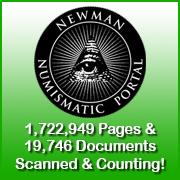
About UsThe Numismatic Bibliomania Society is a non-profit organization devoted to the study and enjoyment of numismatic literature. For more information please see our web site at coinbooks.org SubscriptionsThose wishing to become new E-Sylum subscribers (or wishing to Unsubscribe) can go to the following web page link MembershipThere is a membership application available on the web site Membership Application To join, print the application and return it with your check to the address printed on the application. Print/Digital membership is $40 to addresses in the U.S., and $60 elsewhere. A digital-only membership is available for $25. For those without web access, write to: Terry White, Treasurer AsylumFor Asylum mailing address changes and other membership questions, contact Terry at this email address: terrywhite5475@yahoo.com SubmissionsTo submit items for publication in The E-Sylum, just Reply to this message, or write to the Editor at this address: whomren@gmail.com
BUY THE BOOK BEFORE THE COINSale Calendar
|
- WAYNE'S WORDS: THE E-SYLUM MARCH 21, 2018
- NEW BOOK: REEDED EDGE HALF DOLLAR DIE VARIETIES
- NEW BOOK: STUART DEVLIN
- NEW BOOK: FRENCH INDO-CHINA BANKNOTES CATALOGUE
- COL. E. H. R. GREEN PAPERS ON NEWMAN PORTAL
- NEWMAN PORTAL SEARCH: JUNE 7, 1776
- MORE ON THE MEDALLIC ART COMPANY DIES
- LAURA GARDIN FRASER'S ROOSEVELT PLAQUE
- NEW YORK INTERNATIONAL AIRPORT DEDICATION MEDAL
- NOTES FROM E-SYLUM READERS: MARCH 18, 2018
- STEVE ROACH INTERVIEWS RUSS DOUGHTY
- ROBERT READY’S BRITISH MUSEUM REPLICAS
- VOCABULARY TERM: BULLION
- OTTO CURTIS LIGHTNER (1886-1950)
- POPSICLE TOKENS
- RECOVERING OLD OBSOLETE COMPUTER FILES
- RUTGERS DIGITIZES ROMAN COIN COLLECTION
- THE AMERICAN LEGION COIN DESIGN PROCESS
- BILL SEEKS TO PUT WOMEN ON QUARTERS
- A 16TH CENTURY COIN CABINET?
- NUMISMATIC NUGGETS: MARCH 18, 2018
- THE RALPH AND LOIS STONE COLLECTION
- WAYNE'S NUMISMATIC DIARY: MARCH 18, 2018
- WAYNE'S NUMISMATIC DIARY: MARCH 3, 2018
- THE MAN WHO INVENTED BOOKSELLING
- CIVIL WAR GOLD TALES IN THE NEWS
- GOLD BARS FALL FROM RUSSIAN AIRPLANE
Click here to access the complete archive
To comment or submit articles, reply to whomren@gmail.com
Content presented in The E-Sylum is not necessarily researched or independently fact-checked, and views expressed do not necessarily represent those of the Numismatic Bibliomania Society.
WAYNE'S WORDS: THE E-SYLUM MARCH 21, 2018
 This week we open with three new books, updates on the Newman Portal and the Medallic Art Company dies, and an artwork by Laura Gardin Fraser.
This week we open with three new books, updates on the Newman Portal and the Medallic Art Company dies, and an artwork by Laura Gardin Fraser.
Other topics this week include Robert Ready's Replicas, Popsicle tokens, the American Legion coins, a possible 16th century coin cabinet, and coin designer Stuart Devlin.
To learn more about Reeded Edge Half Dollars, French Indo-China banknotes, U.S. dimes from the Col. Green collection, Carpathia Captain Arthur Rostron's Congressional Gold Medal, the Celtic Coinage of Britain, virgin metal, Hobbies magazine, and the 1792 Barbados Halfpenny token, read on. Have a great week, everyone!
Wayne Homren
Editor, The E-Sylum
NEW BOOK: REEDED EDGE HALF DOLLAR DIE VARIETIES
 Even with 425 copies of Dick Graham's fantastic book "A Registry of Die Varieties of Reeded Edge Half Dollars 1836-1839" produced, there are still too few collectors that know about Reeded Edge Halves. I am attempting to inform additional collectors with my new book entitled "Reeded Edge Half Dollars 1836-1839 - R-4 to R-8 Die Varieties.
Even with 425 copies of Dick Graham's fantastic book "A Registry of Die Varieties of Reeded Edge Half Dollars 1836-1839" produced, there are still too few collectors that know about Reeded Edge Halves. I am attempting to inform additional collectors with my new book entitled "Reeded Edge Half Dollars 1836-1839 - R-4 to R-8 Die Varieties.
The book covers the history of previous authors on the subject and includes extra large photos of the 17 rarest die varieties (not including 1838-O, a proof only issue). There are 38 photos, usually 6" in diameter, along with arrows pointing to the most obvious attributes. The book has protective Mylar covers along with a spiral binding that allows you to open the book and lay it flat to see both pages of a particular die variety. The book has 43 numbered pages and covers my purpose along with Rarity designations. The last section covers the more common die varieties.
It is now available for $29 which includes shipping and handling. If you would like a copy, please send a check or money order to:
Jim Koenings
P.O. Box 2382
Riverside, CA 92516
If you would like your copy sooner, you can send payment through Paypal to my email address of bustcoin1@verizon.net .
As a bibliophile I appreciate the opening chapter on the History of Reeded Edge Half Dollar Books. WhIle I'm a completist and would prefer a book that covers ALL known varieties, I think it makes sense to focus on just the rarest ones (R4 to R9). At least you know if your coin is not here it's probably a common variety. To be sure, Jim provides images of most of the remaining varieties on his web site.
My only complaint is an issue that I would take with any publication using photos of slabbed coins - the white tabs holding the coin in place are evident in the photos and obscure parts of the coin. Unslabbed coins are rare in today's market, but I would much prefer photos taken before the subject is entombed in plastic.
Lastly, I learned about Jim's other interest - Holed U.S. Coins. It's a delightfully obscure topic but I'm glad someone has decided to specialize in it. For more information see http://holeduscoins.com/ . -Editor

NEW BOOK: STUART DEVLIN
Darren Burgess writes:
I thought E-Sylum readers should be aware of a book review that I came across on The Australian Coin Collecting Blog that I think would be of interest.
The review is on a book entitled Stuart Devlin: Designer Goldsmith Silversmith. This new publication covers the work of Australian born Devlin who, among his numerous artistic accomplishments, designed Australia's decimal coinage, first introduced in 1966 and still going strong.
Copies can be purchased in Australia through Renniks Publications.
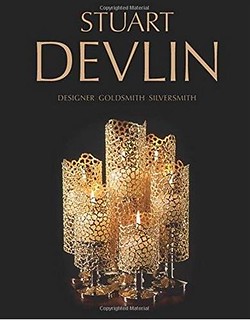 I have never written a book review before and the task for this hefty 529 page pictoral history of Devlins work is eased by the beautiful depictions within the pages. To say I’m a Devlin fan is probably an understatement, his work drew me from coin collecting to arts and sculpture and I have many pieces of his work.
I have never written a book review before and the task for this hefty 529 page pictoral history of Devlins work is eased by the beautiful depictions within the pages. To say I’m a Devlin fan is probably an understatement, his work drew me from coin collecting to arts and sculpture and I have many pieces of his work.
This recently released hardcover masterpiece was assembled by Devlin’s wife Carole and her sister Victoria Kate Simkin after a health scare saw Devlin relent on his negative thoughts on publishing a book. The now 86 year old Order of Australia medal recipient and jeweller to the Queen has achieved so much in his life which is all featured with the pages of this book.
The book begins with a Foreward from Windsor Castle with His Royal Highness Prince Philip Duke of Edinburgh praising the efforts and achievements of Devlin in his lifes work. In each chapter the book carries on documenting much of his work with stunning pictures -it’s almost a Devlin dictionary!
Stuart Devlin is the designer of Australia’s decimal coins first issued in 1966, these were his first coin designs he went on to design coins for over 36 countries! Winning the competition to design Australia’s new coins is said to have transformed Stuart Devlin’s life.
As a Devlin collector this book opened my eyes wider seeing the sheer scale of the items Devlin produced. It’s also help me date and read more about pieces I’ve seen and pieces in my own collection. This book was definitely a must-have for my library. A surprise was that Stuart Devlin designed houses! He did so for the likes of Mick Jagger and H.R.H Princess Margaret. The finale of the book is the extensive biography, more detailed than ever seen before with photos of his private life too.
This publication has a recommended retail price of £75 or $225AUD but I was able to pick up my copy for half that price. Overall this is the most detailed and concise compilation of his work that has gone to print.
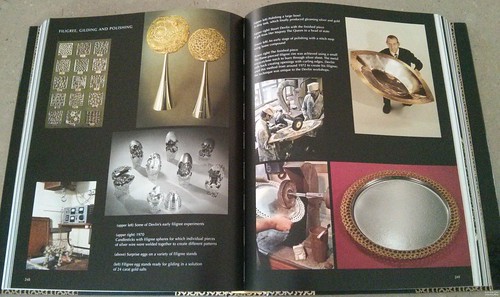
To read the complete article, see:
Stuart Devlin Designer Goldsmith Silversmith 2018 -Book Review
(https://www.australian-coins.com/books/stuart-devlin-designer-goldsmith-silversmith-2018-book-review/)
To visit Renniks Publications, see:
https://www.renniks.com/home.aspx
In 1963 a competition was held to design the new Australian decimal coinage that was to be introduced in 1966. The new decimal coins were to replace the pre-decimal coinage that had been in circulation since 1910. Six competitors vied for the honour of designing these new coins.
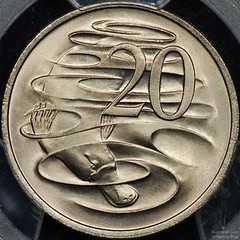 One of these competitors was Geelong born artist and goldsmith Stuart Devlin. Devlin and the five other entrants met monthly in Sydney to discuss their ideas and designs offering each other constructive criticism. Stuart Leslie Devlins designs featured Australian native fauna hoping this would be well accepted by the Australian public. Stuart Devlin was announced the winner with the 1 cent coin featuring the feather-tailed glider, the 2 cent a frilled neck dragon lizard, 5 cent a spiny echidna, the 10 cent a lyrebird, the 20 cent duck billed platypus and the 50 cent Australian Coat of Arms.
One of these competitors was Geelong born artist and goldsmith Stuart Devlin. Devlin and the five other entrants met monthly in Sydney to discuss their ideas and designs offering each other constructive criticism. Stuart Leslie Devlins designs featured Australian native fauna hoping this would be well accepted by the Australian public. Stuart Devlin was announced the winner with the 1 cent coin featuring the feather-tailed glider, the 2 cent a frilled neck dragon lizard, 5 cent a spiny echidna, the 10 cent a lyrebird, the 20 cent duck billed platypus and the 50 cent Australian Coat of Arms.
To read the complete article, see:
Coin Designers Stuart Devlin
(https://www.australian-coins.com/collecting-coins/coin-designers-stuart-devlin/)
NEW BOOK: FRENCH INDO-CHINA BANKNOTES CATALOGUE
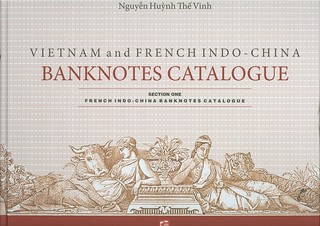 One of my first errands when I was recently back in Viet Nam was to go visit the shop of Nguyen Huynh The Vinh at 27 Nguyen Thi Dieu in District 3 on my first Saturday morning. He is only open on weekends. I am quite familiar with the shop because my friend, Nguyen Huong Quoc used to have it for his numismatic shop before he moved back to the USA with his family.
One of my first errands when I was recently back in Viet Nam was to go visit the shop of Nguyen Huynh The Vinh at 27 Nguyen Thi Dieu in District 3 on my first Saturday morning. He is only open on weekends. I am quite familiar with the shop because my friend, Nguyen Huong Quoc used to have it for his numismatic shop before he moved back to the USA with his family.
When I arrived, the shop was closed but there was no notice published about the closing. There were three other collectors sitting outside drinking coffee at a nearby street cart. I joined them and learned that Vinh frequently closed his shop with no notice. I enjoyed a little time with my friends and then went back to my serviced apartment at Sedona Suites.
I emailed Vinh and he replied that he had to go out on a buying trip and yes, he did not give anyone notice about closing his shop. I told him that was not a good way to treat his customers. Every Saturday I was in Ho Chi Minh City and had free time, I emailed Vinh about my visiting his shop and he told me he would be closed, so I never got to visit his shop.
At one of the Sunday morning collectors' meetings at the Fine Arts Museum café someone told me Vinh had just published a book about French colonial bank notes. I told that person to please acquire a copy for me. At the next meeting, he had several copies and sold one of them to me.
The book is titled Vietnam and French Indo-China Banknotes Catalogue, Section One, French Indo-China Banknotes Catalogue. It was printed by Nha Xuat Ban Tong Hop, in Ho Chi Minh City in 2018 with 265 pages. It is hardbound with very nice covers and thick glossy pages that we might call a coffee table book. It is in English and Vietnamese.

I noticed the notes are all in black lettered PMG slabs from the author's collection and his name has been photoshopped (?) on the label. He does not own most of the early notes so those pages do not have illustrations. So this book is just a representation of a collection and the information about each note appears to be from Kolsky & Muszynski and Pick but there is no Bibliography. Being a cataloger, I hate to be critical of another cataloger, but I emailed Vinh with several questions about the book but to date, I have not received a reply.
This book looks impressive and has excellent illustrations but there is no other reason to own it. It can be purchased from Mr. Nguyen Ngoc Viet, who can be contacted at Viet@UEH.edu. It is heavy (25 x 30cm) book so be prepared to be shocked by the cost of the postage. Mr. Viet is an old friend who has assisted me in printing some of my past catalogs. He is planning to sell many numismatic and philatelic books on his website.

COL. E. H. R. GREEN PAPERS ON NEWMAN PORTAL
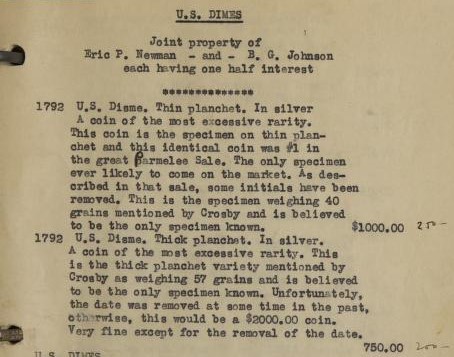
Eric P. Newman and Burdette G. Johnson’s acquisition of coins from the estate of Col. E. H. R. Green is a well-known story in American numismatics, one that greatly contributed to the formation of one of the greatest American collections. The lion’s share of the best federal coins in the Newman collection originated with Green, and were prominently featured in the Newman II sale in November 2013, conducted in New York by Heritage Auctions.
Held by Newman since the 1940s, the Green estate coins attracted substantial attention, in particular the magnificently toned U.S. silver coinage. In total, the Newman II sale realized $23.4 million. Newman’s involvement with the Green collection began on August 12, 1939, when currency dealer D.C. Wismer wrote to Newman “I am sending my list of my original collection of Missouri notes sold to the late Col. E. H. R. Green.” In offset type, suggesting it was added as an afterthought, Wismer writes “I do not wish to have this reported of broadcast.”
Newman did not broadcast it, but three days later penned a letter to the administrators of the Green estate inquiring as to the possibility of purchasing the Missouri currency from the estate. From there, the rest is history, as Newman and Burdette Johnson had their pick of the Green collection and purchased substantial portions over the next several years. Detailed in this archive are Newman’s extensive correspondence and purchase records from the estate.
Image: Record of U.S. dimes purchased from the Green collection by Newman & Johnson. Listed here are two of the three known 1792 pattern dismes in silver.
Link to D.C. Wismer correspondence on Newman Portal:
https://nnp.wustl.edu/library/archivedetail/514234
Link to Col. E. H. R. Green estate papers on Newman Portal:
https://nnp.wustl.edu/library/archivedetail/525101
NEWMAN PORTAL SEARCH: JUNE 7, 1776
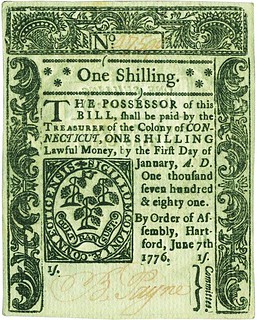
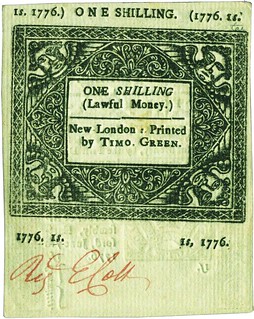
This week a Newman Portal user searched on “June 7, 1776.” I’ve seen enough Newman Portal searches to know this is most likely in reference to a colonial paper money issue. Indeed, that is the case, as June 7, 1776 indicates a Connecticut currency issue of $200,000. The 5th edition of Eric P. Newman’s Early Paper Money of America is available on NNP and contains a summary of this currency issue:
£60,000 ($200,000) in Treasury Notes dated June 7, 1776 due on Jan. 1, 1781 and similar to prior issue. £10,000 of the issue was to be 6s and below and signed by one committee member. Others required two signatures. These bills have the same signers as prior issue plus William Fisher and Nathaniel Needham. Some bills are slash or hole cancelled and others show redemption registration written in by the comptroller. A 1771 restriction on use of bills of other colonies was repealed as unjust.
Bills were denominated from one shilling up to two pounds. The issue was cataloged as early as 1872 in John Haseltine’s Description of the Paper Money issued by the Continental Congress of the United States and the Several Colonies. “June 7, 1776” also appears in various places in the Newman correspondence, for example in 1967 he wrote to Captain V. L. Bigsby of Washington, DC:
You were kind to make such nice comments about EARLY PAPER MONEY OF AMERICA and coming from you it means a great deal to me. I admit that I put in thousands of hours and hope that the numismatic public will be pleased with the publication…… Ken Bressett and Whitman Publishing Company [Krause published later editions] really went all out to do a fine job……As to the Connecticut six shilling note of June 7, 1776, I have a picture of one….
Image: Connecticut one shilling note, issue of June 7, 1776, from Early Paper Money of America
Link to Early Paper Money of America (5th edition):
https://nnp.wustl.edu/library/book/523311?page=115
Link to John Haseltine’s Description of the Paper Money….:
https://nnp.wustl.edu/library/book/520719?page=13
Link to Newman/Bigsby correspondence:
https://nnp.wustl.edu/library/book/520562?page=16
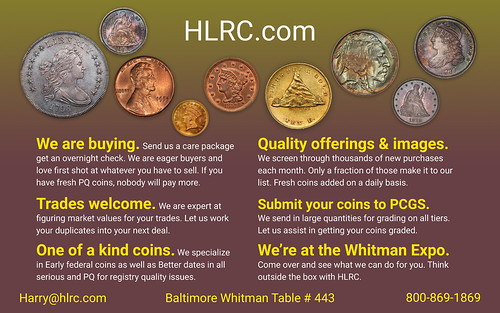
MORE ON THE MEDALLIC ART COMPANY DIES
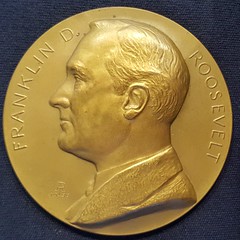 Two of last week’s article resonated with me because of recent additions to my medal collection. The
first was the article on Adam Pietz, which was a follow up on the previous week’s piece featuring the
video of the Philadelphia Mint in 1940. Along with footage of Pietz, we briefly see Chief Engraver John
Sinnock working on the clay model of the obverse of the FDR Presidential Medal, which was actually the
second version he had done of Roosevelts portrait, entering production late in his first term (why is
Sinnock working on it in a film made five years later?).
Two of last week’s article resonated with me because of recent additions to my medal collection. The
first was the article on Adam Pietz, which was a follow up on the previous week’s piece featuring the
video of the Philadelphia Mint in 1940. Along with footage of Pietz, we briefly see Chief Engraver John
Sinnock working on the clay model of the obverse of the FDR Presidential Medal, which was actually the
second version he had done of Roosevelts portrait, entering production late in his first term (why is
Sinnock working on it in a film made five years later?).
The connection to Pietz? Well, I recently bought an example of his rare 1933 medal of Roosevelt. It’s unknown whether this was an unsuccessful competitor with Sinnock’s medal(s), or an independent effort by Pietz, the mint’s number two engraver. A nice job, though I think Sinnock’s does a better job of capturing the President.
The second connection was with the article detailing the sale of the assets of the Northwest Territorial Mint and the Medallic Art Company, specifically the Medallic Art dies. You have to have a bit of unease at the thought of Society of Medalist and other historical dies ending up in the wrong hands (China, anyone?). The old/new Medallic Art was already monetizing the old dies. Last year, they began offering restrikes of various SOM issues, priced at an aggressive $250 – doubt they sold too many at that price point.
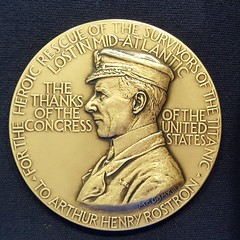
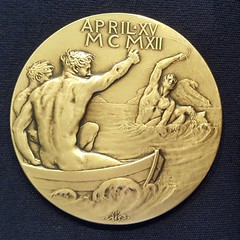
What got my attention, though, was their offering of a bronze restrike of the Congressional Gold Medal awarded to Captain Arthur Rostron of RMS Carpathia, rescue ship of the Titanic. This is not an easy medal to find. A search of the Newman Numismatic Portal turns up only one sale, a bronze example in a 1985 Presidential Coins & Antiques auction. Nothing in the Heritage or Stacks/Bowers online archives or in the ANS collection database. You can understand Medallic Art’s enthusiasm for marketing the medal.
Less clear is their legal standing to do so. While Congress authorized a gold medal for Rostron, they did not authorize the striking of any copies. I would be surprised if they actually owned the dies; they were bought and paid for by the United States, and are likely the property of the Treasury Department. Use of public property for private profit is generally frowned upon.
And then there’s the cryptic reference to this medal in the blog following the NWTM/Medallic Art saga.
In his March 12 post, the author talks about the scrap value of the various dies. He then writes;
Hmmm. Curious and curiouser. You’ll be happy to know, though, that I overcame my qualms and bought
an example last fall for a cool $150, plus shipping, before the doors closed. It will be interesting to see if
any more turn up.
To read the About.ag blog on the Northwest Territorial Mint:
To read the earlier E-Sylum articles, see:
David Luftig of New York City writes:
I attended an event at the Roosevelt Hotel in NYC this week. This plaque was done by Laura Gardin Fraser, and I thought readers would like it.
One of the most prolific female sculptors of the early 20th century, Laura Gardin Fraser is known in both the art and the numismatic worlds. Besides numerous medals she is probably best remembered for her designs of several classic commemoratives, some of which were designed together with her husband, James Earle Fraser.
To read the complete article, see:
Prompted by the recent exchange in The E-Sylum on medallic orientation I took a very suspect medal into the monthly luncheon of the Golden Eagles of the Ozarks' Coin Club on Friday March 9th. Here is a report that will be published in The Flying Eagle, the monthly newsletter of the club later this month.
The 1948 New York International Airport Dedication Medal was shown to the members and passed around the room with the question: Is the reverse oriented properly or not? One member, Don Eggerman figured it out. This is the medal; 3-inch version.
There is a small version of this medal and it is HK-499. The 1st edition (1963) of the So-Called Dollar catalog by Hibler & Kappan described the reverse as "Clouds at top above large radar-like installation." The 2nd edition (2008) got it right; "Clouds at top above layout of roads and runways at airport."
But is the 'top' the top? There are clues it might not be. Should not the bottom legend split the bottom of the medal? Not off-center into the lower right quadrant. But the biggest clue of all is the arrow pointing North in the far right field. If the medal is realigned so the arrow actually points North, that automatically brings the legend to the bottom of the medal splitting left and right.
Of course, to add to the confusion the arrow on the medal points to True North while the airport is laid out to magnetic north. The angle of declination at JFK is 12.99°W. I’m sure the sculptor did not have a clue about that issue. So when the little arrow is pointing straight up i.e. True North, the layout of the airport is off 13 degrees clockwise. Another 'which way.' (I think I have my airport geometry right.) For those with local knowledge, the road coming out of the cloudbank is the Van Wyck Expressway.
This medal has confounded many people over the years including the team that struck it at The Robbins Co. There they organized the obverse to match the coastline of Jamaica Bay on the reverse as if it were an horizon line. And thus creating the 'large radar-like installation.' The two horizontal runways that almost match Jamaica Bay's coastline helped add to the illusion. They struck thousands with this orientation.
On December 24, 1963 the airport was renamed John F. Kennedy International just one month after Kennedy's assassination and from then on would be known simply as JFK. Two years later I worked as a ticket agent at TWA in their wonderful JFK Terminal Building designed by Aero Saarinen. He designed the Gateway Arch in St. Louis.
The building was recently purchased by a hotel chain and they are remaking it into the TWA Hotel opening in 2019. 505 rooms. It is on my bucket list to spend a night there in luxury and to remember the miserable nights I spent there curled up in a steel chair in the agents' locker room waiting for late plane arrivals.
To read the complete article, see:
More on Anamorphic Perspective
The 3rd edition of Celtic Coinage of Britain has something like 2000 images you can use to play this game. You just need to tilt your phone or tablet.
I launched the third edition of the book last December, it’s a completely revised edition of my 1989 book. Free on the internet for everyone.
To read the earlier E-Sylum articles, see:
Hetrich’s No. 10600 Civil War Token
There is a “probable” answer to my earlier question regarding Hetrich’s no. 10600. Susan Trask, President of the Civil War Token Society, offers a plausible solution.
Susan Trask writes:
I rechecked the book and did find 1006 which are H&G dies 145/260. Converted to Fuld numbers this would be Patriotic Token 200/346. It has "New-York" on the obverse and "Constitution and the Union" on the reverse. These are relatively rare. The 200/346a (in copper) is a rarity 7, 11 to 20 known. The 200/346a over NY630W is rarity 8, 5 to 10 known. The 200/346e (white metal) is a rarity 9, 2 to 4 known. This could be the piece he was looking for as he was pretty specific TWICE that the number was 10600. He did mention that the request had been hand written, so maybe it was mis-stated.
The published H&G numbers only went to 10506, a Store Card from White Water, WI.
John Ostendorf writes:
"Susan’s reply is as good a theory as I could propose. The token was obviously rare to warrant $2.50 in 1928. Temple was buying R-9 and R-10 tokens for less than a dollar in the 1940s. Could ‘10600’ been a temporary number that Hetrich assigned to the token when examining the token but away from his notes? The second paragraph of the letter implies there were about 100 unattributed tokens out there since the 1924 work.
Bob Rightmire adds:
When Guttag was selling this token for $2.50 in 1928, that’s more than $500.00 today.
For information on the Civil War Token Society, see:
To read the earlier E-Sylum article, see:
Query: Guttag Brothers Store Card Information Sought
Here's another Guttag Bros. question, this time about a
Guttag store card. This mule, in lead, 10.40 grams, 28 mm, incorporates the obverse from their 1923 token with their 1926 token. My research has yielded little information about it other than King listing it as no. 1065 and Ginther citing that at least three are known. It’s not in the American Numismatic Society Guttag collection. Might any subscriber provide additional information? A census would be helpful too.
Query: "One Tongue" Token Information Sought
I thought I'd send another mystery token for the readership to look at. It is some sort of white metal, but not lead. It has a reeded edge & is about 27mm. The obverse has a monogram which appears to be "V B & A".
It is the reverse that is intriguing, "One Tongue". Could it be some sort of denomination? The "x" appears to be part of the striking, and not done afterward. It looks almost like a communion token, but I am not sure. Anyway, the last time I sent something in the readers took less than two weeks to come up with the answer, so I'd like to try again.
To read the earlier E-Sylum article, see:
Query: Polish Medal Identification Sought
I have an inquiry of my own since it seems like the E-Sylum readers either know everything or at least know where to find the information. Attached is a picture of a medal in my collection. It is 75mm and 9.5 ounces. I believe it is a Polish medal since there is a map of Poland on it. After hours of online research I can find nothing on it. Any help by readers would be appreciated.
Chris Bower adds:
My wife had found that there was a 1966 celebration for 1000 years of Christianity but we are unsure if this is related to that.
Origins of the Word "Znachki"
Joseph Alan Barnosky writes:
In the article about uploads of the Alaska Znachki Bulletin to the Newman Numismatic Portal, Project Coordinator Len Augsburger refers to the word "Znachki" as ""far outside the lexicon of most readers". True enough, and that is, to me, with a year of Russian studies. On my mind, though, is a feeling of need to mention how much closer to home the word's root is.
In the 2015 Standard Catalog of World Coins entry for Spitzbergen, the same word's root, "znak" is used for token. I think the plural is "znaki". It means "sign". It might not be very difficult to extend the usage too far, such as "plus sign" making sense, but "stop token" getting your source questioned, so, I wouldn't take that vocabulary too far afield, but tokens being of much interest to many numismatists, that the word of so many for tokens is so close at hand was, I thought, noteworthy.
To read the earlier E-Sylum articles, see:
On the David Litrenta Tokens
The David Litrenta tokens are included in my list of personal tokens of numismatists. Litrenta appears in the index as being on page 213. That page includes a description of five Litrenta tokens. These were produced by the Patrick Mint.
To read the earlier E-Sylum article, see:
St. Patrick's Day Teaser
It’s Irish. Looks like a medallic object. But what is it?
Answer below.
It’s a coverware serving dish. It does look like a medallic three-leaf clover, but the “petals”
are cavities for serving food. It’s a $1,500 art creation by Evs Zeisel.
Steve Roach of Coin World writes:
I'm glad to see readers learning about Russ Doughty's new book The Top Flying Eagle and Indian Head Cents in the March 11 issue. I met Russ at the 2016 ANA Summer Seminar where he was part of the class I taught on Numismatic Publishing. I interviewed him for the November 2017 monthly issue of Coin World where he had some great advice for new authors.
Q: How did you start coin collecting?
Q: How did you discover your passion for Indian Head cents?
Q: What made you write The Top Flying Eagle and Indian Head Cent Die Varieties and what makes your book different?
Q: What’s the toughest thing about writing a book, and what advice would you give to new authors?
To read the earlier E-Sylum article, see:
This statement was in a recent E-Sylum [Italics added]:
“In the past, the British Museum shared numismatic knowledge with other museums, in what could be seen as an early numismatic network, by making and distributing replicas of coins from its own collection. The examples chosen were considered by the Museum to be particularly fine examples of coins from different periods, and their distribution enabled other institutions to share the Museum’s collection. The British Museum shares numismatic knowledge in different ways today, through projects like the Money and Medals Network.”
These replicas were electrotypes created by a museum employee. Hired in 1859, Robert Cooper Ready (1811-1901), replicated objects – including coins – in the Museum's collections. After first casting these Ready turned to electroforming the coins, because of the sharper detail he could obtain by this process. In his lifetime Ready made over 22,000 of these coins; his sons, Augustus P. and Charles Joseph Ready carried on after him. Each signed their electrotypes, RR by the father R and MB (reversing British Museum initials) by the sons.
Ready’s replicas were so exquisite it was hardly possible to distinguish from the originals. (It is rumored that collectors occasionally paid more for his replicas than the originals.) The practice of electrotyping coins was halted and replaced by plaster casting in the 19th century. Using plaster casts was satisfactory for studying the image, but of course, unsatisfactory for studying the metal surface, toning and patina.
Many books, however, were illustrated with photographic plates, composed entirely of plaster casts. Perhaps this should be discussed in a future E-Sylum. But for now we should recognize the Ready family for their outstanding lifetime achievement. Their replicas rest in museums for generations to view, to study, and advance numismatic science.
To read the earlier E-Sylum article, see:
Joe Cribb adds:
MB represent the Latin name for the museum, rather simply a reversal of its initials. I attach images from Forrer’s Biographical Dictionary of Medallists which has a little more information on the Readys.
Benjamin Alsop writes:
Attached is an image of a Roman Provincial electrotype coin of Hadrian from Elis which was made by Robert Ready. I’ve managed to get an image of the edge with his initials as well.
Bullion.
Metal with all impurities removed; usually in ingot form and prior to any step of manufacturing. Bullion may be any metal, notably in pure form, but is often considered as precious metal only. The metal for all coins and medals must at some prior time have been in bullion form. Makeup of the composition for intended coinage metal, called FORMULATION, may include some form of alloyed metal – as previous coins melted for reuse, or some form of scrap metal – or it may be virgin metal (as direct from the refinery). Any of this metal may be called “bullion.”
Refinery bullion. Refineries prepare metal by purifying it, separating if from other metals or mixing it to a needed formulation. Virgin metal is never pure when it comes from ore, nature has a way of mingling metals in their natural state. Man’s task is to separate these. Metal derived from ore is first granulated then treated by a variety of physical and chemical processes.
After purification the molten metal is poured into molds and allowed to cool. These cooled ingots are cleaned of surface impurities (wire brushed or filed) if necessary and marked in some way. Most ingots are marked with a PUNCH or punches to identify the refiner, the weight, the purity, any marks the refiner wants to identify that ingot (as perhaps, a serial number or melt number).
Ingots can then be stored, shipped, transferred to another operation (as rolling mills, wire mills, tube mills or however the metal is to be fabricated). For coinage metals bullion ingots are shipped to a mint.
Coinage bullion. When preparing for a coinage metal, bullion is ASSAYED for precious metals or analyzed for base metals to determine its exact metal content. It is then combined by precise weight to form the required metal ALLOY composition. For precious metal coins – gold, silver, platinum – these assays are very precise to meet the exact requirements for coin metal standard (FINENESS), usually prescribed by law. For other alloys, particularly base metals, as bronze and zinc, there may be more leeway, called TOLERANCE.
This formulated mixture is melted (in a mint’s melt shop) and agitated to form a homogeneous new alloy. The molten metal is poured into molds (open or book molds) to cool forming ingots, sometimes called fillets. These ingots are surface wire brushed to remove the burrs, then swaged (end flattened) to be able to feed them into a ROLLING MILL to be rolled into strips.
A physical imperfection in the bullion at this time is not serious (since the physical form will change); a chemical imperfection in the bullion, however, is serious as it may continue through rolling and blanking, and even into the final pieces after striking. See INGOT.
Bullion that is incorrectly formulated is called BULLION BLUNDER. It may have a slight color variation but this error is very difficult to discern unless a chemical analysis is made. Alloyed metal that is not blended correctly is called INHOMOGENEITY; such metal may display off color streaks in strips, blanks or even struck coins.
Ownership of bullion has become popular with the public, specifically for investment. In small amounts this desire has been fulfilled by the manufacture of BULLION COINS, BULLION MEDALS and COINED INGOTS. These are sold to investors who like to take physical possession of the pieces themselves. Even national mints have struck bullion coins and medals to meet this demand, first supplied by gold Krugerrands from the South African Mint beginning in 1967.
The appeal of diestruck bullion pieces – coins, medals or ingots – is their guarantee of purity, their convenient form for any transaction, and their convenient size, in fractions or multiples of an ounce. Both buyers and sellers are willing to accept the standards usually stated on the piece. It is not necessary to assay such coined bullion pieces for purity and weigh at every transaction. Those facts are stated right on the piece.
The easy availability for more than a century of bullion from metal suppliers has eliminated the custom of jewelers and craftsmen from melting coins as a source of their metal. Silver, for example can be obtained as fine silver (.999), STERLING SILVER (.925), COIN SILVER (.900) or any specialty
alloy.
REFERENCES:
Looking for the meaning of a numismatic word, or the description of a term? Try the Newman Numismatic Portal's Numismatic Dictionary at:
https://nnp.wustl.edu/library/dictionary
Otto Curtis Lightner (1886-1950), was born on July 2, 1886, Norwich, Kingman County, Kansas, son of James Edwin Lightner (1854-1930), a merchant and native of Pennsylvania, and Maria Catherine Hoover (1861-1946), a native of Ohio.
The Lightner family were part of the American colonial period when German Lutheran immigrants who fled religious persecution went to London, Surrey, England, and many migrated to both Ulster County, New York, Canada, and into Pennsylvania.
Beginning with Nathaniel Ignatius Lightner (1709-1782), and his father Johann Adam Lightner (1678-1736), whom the latter was born in Germany, came to America first settling in Ulster County, New York before finding their way into Lancaster, Pennsylvania. Johann Adam Lightner fought during the American Revolutionary War. Otto C. Lightner was a member of the Sons of the American Revolution.
He grew up in Wichita City, Kansas with his four brothers...
On July 2, 1904, his eighteenth birthday, he delivered a speech titled : "How Christian Endeavor Will Influence the Future Destiny of Our Country," at the Christian Endeavor Rally held on the nomination of Theodore Roosevelt for President.
In September 1904 he was elected to the Young Men's Republican League.
In June 1905, he bought out a wholesale stock of millinery goods, running advertisements in the Wichita Daily Eagle, looking to hire two experienced street men and two traveling salesmen, selling hats, call third floor, National Bank Building.
In 1911, he was the president of the Associated Trade Press Company, Room 305, 123 East 6th Street, Cincinnati, Ohio.
On February 12, 1920 he started his own company the Lightner Publishing Company, New Orleans, Louisiana. His first periodical was titled Strawberry Items, published for strawberry growers.
In April 1922 he published the Peanut Promoter, for the peanut growers, but was soon sued by Colonel John F. Penner, Secretary of the Suffolk Peanut Company, for libel. When Penner saw Lightner on the street he struck him several blows.
In 1930, about the time of the death of his father, he purchased Philatelic West, and began with Volume 36 but renamed the publication Hobbies, The Magazine for Collectors.
The first numismatic editor of Hobbies was Clay Lewis Huntley (1881-1965), a salesman, who joined the ANA in 1932 in order to attend the annual convention held that year in Cincinnati, Ohio, and to write a detailed report for Hobbies.
Lightner tragically killed a 7 year old child hitting her with his car. The Times, Tuesday, March 7, 1950, page 5
He died on June 9, 1950, three months after that fatal and tragic car accident, at Presbyterian Hospital, Chicago, Illinois. He is buried at the Lightner Museum, Saint Augustine, St. John's County, Florida.
To read the complete article, see:
The Lightner Museum
The Lightner Museum is housed in
the former Alcazar Hotel built in
1888 by Henry Flagler.
Today it is home to
one of the best collections
of fine and decorative
19th century art in the country.
St. Augustine's "Lightner Museum of Hobbies" opened in 1948 with the collections of "Gilded Age" artwork, antiques and curios of Otto C. Lightner. As once-proud Chicago estates were put up for auction or sold for taxes during the Depression, Lightner quickly purchased the collections of millionaires that had been acquired over a lifetime.
From typewriters to Tiffany,
Otto Lightner’s collection of fine
and decorative art from the 19th century
is impressive and extensive.
The Museum’s eclectic collection
ranges from a mummy, shrunken heads,
human hair art, cigar labels, buttons,
salt and pepper shakers, to Tiffany glass,
cut glass, porcelain, fine art paintings,
furniture and sculpture all housed
throughout the four floors of
the original Alcazar Hotel.
For more information about the Lightner Museum, see:
To read Hobbies on the Newman Numismatic Portal, see:
The entire inventory of the Lupia Numismatic Library is for sale. Individual items will be available before the remaining archives are broken up into parcels sold at philatelic auctions in the U. S. and Hong Kong. Check
NumismaticMall.com frequently as dozens of new items with estimates will be posted daily until everything is sold.
All inquiries will be given prompt and courteous attention. Write to:
john@numismaticmall.com
.
Dick Johnson writes:
Up til now researchers have not been able to document who engraved the dies for a series of Popsicle tokens issued as premiums in Popsicle packages. It may have been Adam Pietz as mentioned by David Hill in last week’s E-Sylum. At least two were issued in 1933 featuring movie stars Clark Gable and Greta Garbo.
Later, in 1937, six were issued and we know for certain these were engraved by German-American engraver Franz Eue. These bore portraits of Claudette Colbert, Gary Cooper, Jean Harlow, Frederick March, Norma Shearer and Johnny Weissmueller. He misspelled Popsicle on the reverse of the Claudette Colbert medal as POPCICLE. Three of these are listed in the Red Book by Katie Jaeger and Dave Bowers, A Guide Book of U.S. Tokens and Medals, page 149.
Franz F. Eue (1888-1937) was a hand engraver, medalist and sculptor. He engraved German portrait medals in 3 and 5 –mark size (gedenthalers) for at least four German medal firms prior to his immigration to America in 1926. It is said he could engrave a die in two hour‘s time, either carving intaglio or cameo. He engraved a number of dies for Medallic Art Company. A contemporary of his told me once he loved to drive old cars until he wrecked and then abandoned them.
David Hill writes:
The ANS has 10 of these. I included the two that say Popsicle on the back. Our Claudette Colbert doesn’t have the misspelling noted by Dick and, in fact, doesn’t say Popsicle at all, so I included that, too.
To read the earlier E-Sylum article, see:
One workaround to make these projects possible was to separate a website from the web. “A simple solution was to simply burn all the the HTML, JavaScript, and other large files to a CD-ROM,” Walsh says. These sites spent much of their lives offline—viewable only when a user met the hardware requirements listed by the creator and then inserted the CD. Today, with a decent connection, online video and all sorts of other functionality rarely stumbles. In the march to high-speed wi-fi, browser-based applications, cloud computing, and computers that have no need for CD-ROM drives, some older digital artifacts have been left in the dust. In some cases, it’s as though they’re written in a dead language, so accessing their content can be tricky.
The digital world continues to expand and mutate in all sorts of ways that will orphan and otherwise impair file formats and programs—from ones long forgotten to ones that work just fine today but carry no guarantees against obsolescence. Instead of a patchwork of one-off solutions, perhaps there’s a better way to keep old software running smoothly—a simpler process for summoning the past on demand. A team at the Yale University Library is trying to build one.
DIGITAL ARCHIVISTS DEAL WITH LEAST two broad categories of artifacts. There are analog objects or documents scanned into a second, digital life—digitized maps, for instance, or scanned photos. The other objects are natives of the digital world. These files can include everything from a simple compressed image to a game on a CD-ROM to a CAD design for a skyscraper. The relentless march of new versions and new platforms makes obsolescence a constant presence, from as soon as digital objects are conceived.
RESEARCHERS AT YALE ARE WORKING to solve this problem by creating a kind of digital Rosetta Stone, a universal translator, through an emulation infrastructure that will live online. “A few clicks in your web browser will allow users to open files containing data that would otherwise be lost or corrupted,” said Cochrane, who is now the library’s digital preservation manager. “You’re removing the physical element of it,” says Seth Anderson, the library’s software preservation manager. “It’s a virtual computer running on a server, so it’s not tethered to a desktop.”
Instead of treating each case as a one-off, like digital triage, this team wants to create a virtual, historical computer lab that’s comprehensive and ready for anything. Do you have a CD-ROM that was once stuffed in a sleeve on the cover of a textbook? A snappy virtual machine running Windows 98 might be able to help you out. “We could create any environment that we needed,” Anderson says. The goal is to build an emulation library big enough that there’s a good fit for any potential case—with definitive, clear results. Cochrane said the integrity should be strong enough that “you can take an old digital file into court as evidence.”
Len Augsburger of the Newman Numismatic Portal writes:
We will fund this work if the content value is there. For example, if someone had a book draft on floppy disk, that would be a no-brainer.
As far as I know the record is held by Martin Gengerke who started his work in the 1980s (possibly 1970s) and has managed to keep American Numismatic Auctions digitally accessible.
To read the complete article, see:
To read the earlier E-Sylum article, see:
The digitization of ancient coins is not some retro version of Bitcoin. Through a collaboration of classical scholarship and super high-resolution photography, the goal was to make multi-angle views of these coins – some of copper, some of bronze, silver or gold, all bearing fascinating engravings – available for study by scholars and students while protecting the originals.
Anyone with an Internet connection can now zoom and pan all 1,250 digitized coins free of charge, via the Coins portal. Visitors to the Alexander Library at Rutgers University–New Brunswick can view several of the actual coins, along with reproductions of the new digital images, at an exhibit opening March 23 in the Scholarly Communication Center.
The Badian Collection of Coins of the Roman Republic is named for Ernst Badian, the late Harvard University professor who donated the vast collection to Rutgers thanks to his connection to Brennan, who was his student.
“The Libraries, the Classics Department and the School of Communication and Information all collaborated to make this happen,” said Ronald Jantz of the Shared User Services unit of the Rutgers University Libraries, who oversaw the digitization project along with Brennan.
The bulk of the work was done by Rick Hale, a classics doctoral student in the School of Graduate Studies, four library school students from SC&I, and several part-time library employees. The digitization, description of the coins, and upload to Rutgers Institutional Repository (RUcore) spanned about four years and required patience, skill, knowledge of ancient coins, advanced technology and improvisation.
“At first, showing multiple angles for each coin meant we had to manipulate them manually — shoot straight on, move the coin a few degrees, shoot that image, and so on,” Hale said.
Although the multiple-angle approach did have some advantages, the Coins team switched to taking images of the obverse and reverse of each coin in order to expedite the imaging process. Late in the project, Aaron Hershkowitz, also a classics doctoral student, joined the team and brought with him a knowledge of a new technology “reflectance transformation imaging,” or RTI, with which Hale and Hershkowitz began to experiment toward the end of the project. In RTI, the coin is placed inside an LED-studded dome, making it possible to shoot multiple views by manipulating the lights, not the coin. The RTI technology holds great promise for continuing to improve the coin imaging process.
To read the complete article, see:
Celebrating the American Legion—and America’s Veterans—With Coins
What comes to mind when you think of the American Legion?
My mind also goes to a very tangible symbol of the American Legion: its circled-star emblem. I imagine
everyone who has ever looked through Grandpa’s cigar box of military medals, old coins, and war
souvenirs has seen the American Legion emblem, on a hat or lapel pin, challenge coin, or other memento.
I have one of my Uncle Marshall’s membership badges.
Even without that direct family connection, people across the United States are familiar with the circled-
star emblem. There are nearly 14,000 American Legion posts active in communities in every state of the
nation plus the District of Columbia, Puerto Rico, the Philippines, France, and Mexico. They are a robust
presence and a strong force for civic good, offering scholarships, education, advocacy, health services,
mentoring, emotional support, and other valuable programs.
The American Legion was founded on four pillars: veterans’ affairs and rehabilitation; national security;
Americanism; and children and youth. These pillars are embodied in Legion programs that benefit our
nation’s veterans, its active service members, their families, the youth of America, and everyday citizens.
The American Legion’s Commemorative Coins and the CCAC
Monday, March 12, 2018, I flew to Washington, D.C., for a next-day meeting of the Citizens Coinage
Advisory Committee. The American Legion was very much on my mind.
The CCAC was formed by Congress in 2003 as a public organization that advises the secretary of the
Treasury on designs and themes for all U.S. coins and medals. The committee’s members hail from
Washington State and California in the West, New York and New Jersey in the East, and points in
between. There are eleven of us, each one representing the interests of the general public as well as coin
collectors, and several drawn from specific disciplines and areas of expertise. Many of us are longtime
active numismatists.
On this particular day in March at United States Mint headquarters on Ninth Street in Washington, our
agenda included planning for a three-coin suite of commemoratives celebrating the 100th anniversary of
the American Legion.
By the time we convened, the Mint’s program managers had already met with leaders of the American
Legion. Artists from the team of medallic sculptors at the Philadelphia Mint, and from the Mint’s Artistic
Infusion Program, had contributed their creativity to a portfolio of design proposals for the three
1919–2019 coins: a copper-nickel half dollar, a silver dollar, and a gold $5 piece. We members of the
CCAC had received a dossier of these designs, sixty-four in total, in advance of our meeting. We came
prepared to discuss their merits in a public forum and in conference with the American Legion, and to
make our formal recommendations to the secretary of the Treasury.
Approaching the Coin Designs: “Getting it Right”
We were honored to have the Legion’s executive director, Verna Jones, present at the meeting, along with
Chanin Nuntavong, deputy director for media relations. Jones is the first female executive director of the
American Legion. She spoke passionately about how the Legion wants its commemorative coins to
represent all two million–plus of its members, and therefore its leadership leaned away from designs that
show faces—because, for example, featuring just one ethnicity would leave out many others. Jones
emphasized the weight and significance of the Mint’s design process, and the importance of getting it
right. A 100-year anniversary only comes around once. “We have one opportunity to show inclusion,” she
said, noting that women were allowed to vote for the American Legion’s national commander before they
could vote for the president of the United States. The older, white, male veteran is “only one part of the
American Legion,” she said. It’s interesting to observe that Jones and Nuntavong, our two organization
liaisons at the CCAC’s public meeting, are an African-American woman and an Asian man—reflections
of the diversity Jones spoke of. “I want the coins to represent everyone whose blood, sweat, and tears
made the American Legion what it is,” she told us.
Reviewing and Analyzing the Designs
Before the Mint’s artists started sketching for this program, the Mint had encouraged them to submit
design proposals as obverse/reverse pairings. This strategy, developed in recent years, avoids some risks
and challenges inherent in two separate artists creating one side each of a given coin. For example, two
individually excellent designs might have jarringly different styles. Or they might both have higher-relief
areas that would be coined opposite each other on the planchet, resulting in poor metal flow and a shallow
strike. In theory a skillful artist, envisioning the entire coin, obverse and reverse, can plan a more coherent
and coinable result.
As I reviewed the design proposals, my mind kept returning to the importance of the American Legion’s
emblem—that symbol that every Legion member, every military family, and every person who has
benefited from its programs, is familiar with. To me it was crucial that at least one of the three coins
feature the emblem prominently as its main design device.
I also felt it was important to show the emblem in its entirety. Each part holds a specific meaning, and to
use some as design elements while leaving others out does a disservice to the emblem’s intent. The sun’s
rays, seen along the outermost edge, “form the background of our proud emblem and suggest the Legion’s
principles will dispel the darkness of violence and evil.” The wreath, forming the center, is “in loving
memory of those brave comrades who gave their lives in the service of the United States that liberty
might endure.” The star, “victory symbol of World War I, also symbolizes honor, glory and constancy.”
The larger of two outer rings stands for “the rehabilitation of our sick and disabled comrades,” while the
smaller inside ring denotes the welfare of America’s children. “The smaller of two inner rings set upon
the star represents service to our communities, states, and nation. The larger outer ring pledges loyalty to
Americanism.”
In particular I liked obverse 5 of the silver dollar designs. It shows the Legion’s emblem but in an artfully
stylized manner, with oak leaves symbolizing strength and the lily for devotion and memory.
I studied how the American Legion talks about itself today. How does it tell its story? Leading up to our
meeting I spent a lot of time on the Legion’s web site, www.Legion.org. There the organization tells its
story through people, sharing the personal experiences of its members—a human-interest approach.
Several of the proposed coin designs show portraits and scenes of veterans, young and old. Many of those
are emotionally compelling, and several committee members were drawn to them. But we understood the
Legion’s desire to use more symbolism, rather than human figures.
Committee member Robert Hoge, our member specially qualified as a numismatic curator given his
museum leadership with the American Numismatic Society and the American Numismatic Association,
advised the Mint’s artists to use bold designs. “Coins are small,” he cautioned. He also observed that
grayscale, which can make a beautiful drawing, “isn’t appropriate to indicate depth on a coin.” For this
particular program he encouraged the use of the American flag, and approved of the Eiffel Tower as an
instantly recognizable symbol of Paris, where the first American Legion post was started. Other designs
used the Arc de Triomphe, and several committee members commented on the weaker symbolism of that
landmark for this particular program: the famous arch stands for its own specific wars and military
victories.
Committee member Erik Jansen—an engineer, scientist, and co-founder of a medical-device
firm—described his disappointed reaction to the packet of designs: “Nothing came together.” He laid out
his general thinking when it comes to three-coin commemorative programs: the $5 gold piece is “the
over-arching big picture” of the subject matter; the silver dollar is the “trophy,” the big seller, the coin
that deserves the boldest and best design; and the copper-nickel half dollar he sees as the “fun, light,” kid-
friendly option, the least expensive and therefore most accessible of the coins. For the American Legion
commemoratives, he recommended an energetic and “youthful” style, avoiding messages of loss and
sacrifice. “I want an active verb,” he said, “not a sad memoriam.”
Committee member Mike Moran, well known for his deeply researched articles and books on American
numismatic history, echoed Bob Hoge’s warning about the size of the actual coins—“the five-dollar gold
is the size of a nickel.” It’s one thing to design a coin, or to critique a design, blown up to a six-inch
diameter. It must always be envisioned reduced to a much smaller planchet. Moran made an example of
obverses 4 and 10 for the gold coin: “Use one head, not two.” He rejected the Art Nouveau approach of
obverse and reverse 6 of the silver dollar, saying the style hasn’t aged well.
Committee member Heidi Wastweet, a talented and recognized artist and current president of the
American Medallic Sculpture Association, offered observations on several designs, noting that some
sketches proposed as obverses worked better as reverses, and vice versa. She also queried the Mint’s
management on technical points of frosting and polishing of dies. She pointed out places where the artists
relied too much on shading, which can give depth to a drawing, but which can’t be translated to the metal
of a coin (outside of very limited effects given by frosting and polish).
Committee member Donald Scarinci, our longest-serving member and one of the greatest private
collectors of art medals in the United States, gave dramatic condemnation to the portfolio of designs. His
advice to the Mint was to reject them all and start over, calling them “the worst group of coin designs”
he’d seen in years. To our American Legion liaisons, he recommended aggressive marketing in order to
see the surcharges that come from a profitable program, implying that none of the proposed designs had
the merit to easily sell themselves.
Committee member Tom Uram, a well-known life member (and recently elected governor) of the
American Numismatic Association, singled out some favored designs from the portfolio. He also drew
attention to the “V” in gold obverse 3, which ties back to the World War II commemorative coins of the
early 1990s, and he observed that the legend “God and Country” was considered as a motto for our
national coinage during the American Civil War.
Committee chair Mary Lannin, an active scholar of ancient coinage and a member of the Industry Council
for Tangible Assets’ anti-counterfeiting task force, remarked on gold obverse 5’s resemblance to the
iconic American Legion pin, and gave her endorsement to the preferred choices of our liaisons.
Our Votes for the American Legion Commemorative Coins, and Our Recommendations to
the Secretary of the Treasury
Every member of the Citizens Coinage Advisory Committee agreed that this portfolio of designs,
as a whole, was lacking. While it offered some examples of very good artwork, it also included
sketches that wouldn’t translate well into coinage, some retreads of styles we’ve rejected in the
past, and designs that just didn’t work on a number of levels.
April Stafford, the Mint’s chief of design management, has explained to us that their goal is to
“minimize the Mint’s fingerprint” in the artists’ creative process—to give the committee as many
designs to review as possible. This, of course, is after the Mint’s own vigorous series of legal and
technical reviews, which can shape and guide the designs before we see them, making sure
they’re coinable while also meeting the mandates of their legislation.
After much discussion and analysis, including dialogue with our American Legion liaisons, we
leaned heavily toward the Legion’s preferred design pairings. Executive Director Jones identified
the following preferences from the organization’s leadership.
• For the gold coin: obverse 3 (“with its important symbolism”) and reverse 4 (honoring
“the ultimate sacrifice”). (Although obverse 5 for the gold coin is iconic and instantly
recognized, she observed, “Every member already has the emblem on pins, challenge
coins, and other collectibles.”)
• For the silver dollar: obverse 5 (“a beautiful coin”) and reverse 11 (she noted the importance of the theme of 100 years of service).
• For the half dollar: obverse 5 and reverse 6, a pairing that has the pledge of allegiance
starting on the obverse and continuing to the reverse.
Part of our process in coming to a recommendation for any given coin is to take a weighted vote
after we discuss and analyze each design proposal. In this case, our votes strongly affirmed the
preferred designs of the American Legion. We did recommend one modification, for the top
center of the silver dollar reverse: change the large keystone (part of the Arc de Triomphe’s
architecture) to a fleur-de- lis (a more obvious symbol of Paris, where the American Legion
started).
What’s Next for the American Legion Coins
The CCAC itself doesn’t decide what goes on coins. Rather, we provide our studied, reasoned
advice in a formal recommendation to the secretary of the Treasury. Another committee, the U.S.
Commission of Fine Arts, also provides feedback and recommendations. The secretary uses that
input, as well as the insight of relevant liaisons and stakeholders, and then makes the final
decisions on designs.
Once the designs are officially chosen, the Mint’s artists will sculpt them, hubs and dies will be
made, and the coins will continue through the master production schedule of manufacturing,
packaging, and distribution. There will be a launch ceremony sometime next year in conjunction
with the American Legion.
If these designs speak to even a fraction of the American Legion’s membership, and a fraction of
the other Americans who know and love the Legion, the United States Mint will have a very
successful and popular commemorative coin program for 2019.
To read the complete article, see:
Two US representatives -- Democrat Barbara Lee of California and Republican Bruce Poliquin of Maine -- on Thursday introduced a bill that would inject the coin circulation with quarters that feature prominent women from American history.
In a program that would mimic the ongoing commemorative collection that features state landmarks, the US Mint would churn out coins featuring women selected by leaders from all 50 states, five territories and DC. Their portraits would appear on the back side of the coins, opposite George Washington.
"We have so many women, first of all, who are unsung heroes, and their accomplishments haven't been recognized," Lee told CNNMoney. "This bill, and hopefully the coins, will give us a chance to really highlight them and make sure the world really knows who they are and what they have done. I think it's really long overdue."
The legislation, introduced during Women's History Month, would direct the governor or top official in each state or territory to consult with local women's organizations and other interested groups about their pick. No living people can appear on coins, so the women must be deceased, the bill stipulates.
The first design mockups could arrive in 2020, the 100th anniversary of women gaining the right to vote. And Lee said the first coins could enter circulation in 2021.
Lee worked for more than a year alongside former Treasurer Rosie Rios to draft this bill.
To read the complete article, see:
16th Century provenance: Florence, With wooden structure. Provided with front window, complete with functioning lock, with a key. External surface covered with red leather, richly decorated with gilded, imprinted frames of branches and leaves. The hinges and lock with iron plates, partially gilded. Two articulated, iron locks alongside, with traces of gilding as well. Arms of Strozzi-Pandolfini family on the front part. Provided with a wooden dresser (later) that can be inserted inside. dimensions 43 x 39 x 32 cm.
To read the complete lot description, see:
1792 Barbados Halfpenny Token
Lot 352. Barbados. Copper 1/2 Penny Token. 1792. Low mintage.
Barbados. Copper 1/2 Penny Token. 1792. Crowned head left / Neptune in chariot. KM Tn9. VF. Low mintage
To read the complete lot description, see:
1823-Dated Mexico Gold Restrike
To read the complete lot description, see:
1860 Clark Gruber Mountain $10 Gold
Outstanding example of Clark Gruber Mountain Ten. Anyone who has studied these know rough and scrubbed coins are the norm. This one is better than virtually any I have seen within AU classification and better than many low mint state examples.
To read the complete lot description, see:
1937 King George VI and Queen Elizabeth Coronation Gold Medal
A King George VI and Queen Elizabeth Coronation gold medal, by Percy Metcalfe, diameter 57mm
The media played an important part in broadcasting this show of pageantry and imperialism to the Empire, which marked this coronation as an important event in the history of television, being the world's first major outside broadcast. It was also the first coronation to be filmed, as well as the first to be broadcast on radio.
To read the complete article, see:
To read the complete lot description, see:
Sotheby’s is delighted to announce the sale of the Ralph and Lois Stone Collection of United States Silver Morgan Dollars as part of the Historic Coins and Medals Sale. The coins form an essential part of the story of late-19th century America and have long been recognized as important historical artefacts from the period. Complete by date and mintmark, the Stone Collection is one of the finest ever formed, with exceptionally high grades of preservation of the rarest dates in the series. Quietly assembled by Ralph Stone, a discerning northern California banker and collector, the collection has remained unseen and all but unknown to the collecting fraternity since Stone’s death more than twenty years ago. Overall the collection is expected to fetch in excess of $3 million.
Richard Austin, Head of Sotheby’s Books & Manuscripts Department commented: “Sotheby’s has traditionally had great success with extraordinary coin sales and we are excited to offer the Stone Collection on behalf of these long-standing clients. The sale has everything the market desires: rarity, condition, provenance and rediscovery.”
Serving as something of a time capsule, the collection was formed during the first decade of third-party grading. This imaginative concept, where third-party specialist firms authenticated the coins, graded their condition (on a scale of 1 to 70), and encapsulated the coins in tamper-proof holders, transformed coin collecting in the U.S. It is now not only the norm, but an essential part of the collecting experience.
All the silver dollars in the collection were certified and encapsulated by the two major grading services at the time they entered the collection — the Professional Coin Grading Service (PCGS) and the Numismatic Guaranty Corporation (NGC). Furthermore, the majority of the silver dollars have also been reviewed and approved by the Certified Acceptance Corporation (CAC), which examines coins previously encapsulated, and adds its imprimatur to those coins which are exemplars of the grade indicated on the holder. All Morgan dollars will be sold in their original, vintage holders.
For more information, see:
Mouse Pad Mania
David Gladfelter writes:
The mouse pad came out of a U. S. Mint press kit they put out when the Sac dollar was put in circulation. For some reason the kit had two of them so you got the extra. Mine is still kept in the kit so it's an MS70. Should I have it slabbed -- whatcha think?
Dave adds:
These also were in the kit.
The brochure touts various advantages of the dollar coin such as its use in
vending machines. Strangely, it does not mention its prime advantage --
reduction in cost compared with the cost of maintaining a circulating paper
dollar.
Nummis Nova
I was the first to arrive and took a seat at the bar, where I and fellow patrons were entertained by a rather loud woman who is apparently a regular there. I was relieved when she left and happier still to see fellow Nummis Nova regular Eric Schena walk in. He joined me at the bar and we had a nice conversation while awaiting the others.
The rest of the group arrived over the next 15 minutes or so. I sat across from Gene, Dave and Eric, and Wayne Herndon settled in next to me. The other end of the table held Mike Packard, Tom Kays, Robert Hoppensteadt, Steve Bishop and Lenny Goldberg.
Annandale Kids Event
Nummis Nova
Theme is “bling.” Bring something that looks like a million bucks despite whatever its actual worth may be. From rare coin copies to high denomination currency facsimiles let’s see who can impress folks with what looks like a fortune in funny money."
I have two Gallery Mint 1804 Dollars in my collection, but didn't have time to locate and bring them. Here are what others brought. Some stick to the theme, but others are new purchases and other handy items. I brought a couple new books.
Absolute Money Notes
Million Dollar Daivd Litrenta Note
Coin Replicas
But the real treasure was in a box. He writes:
Pictured under glass, in a fine Mahogany relic case, are venerable silver coins of early America. When I bring these cases to dinner, Gene usually opens them up and rearranges things to his artistic liking, after looking at both sides, and here is the result of his Feng shui placement of the cut pieces. I hope they harmonize to everyone’s satisfaction, in this unique configuration.
Pictured are an 1826 eight reales of the Central American Republic (NG – M), a 1617 Lion Dollar of Deventer, and an assortment of non-dug whole, and dug cut, pistareen pieces. The whole coins at center include one of the five unique crown varieties of 1718 from Segovia, an off-center, 1727 Cuenca half pistareen, and a dug 1733 quarter pistareen, a type Gene had not seen before.
All the cut pieces were dug at colonial sites in Virginia and range in dates from 1717 through 1738. These represent a mix of new and old acquisitions which simply look good together under glass, and surrounded by Mahogany. They fit in well with the cozy “Duck Room” atmosphere of our dinner at Clydes of Mark Center. It was marvelous!
“Double Brockages”???
Here are pics of the two “double brockages” (for lack of a better term).
Steve's Beauties
More Pictures
Here are some additional photos I took of our group.
What a great night!
The food and company were marvelous, in a comfortable, relaxing setting. It's always a numismatic highlight of my month. 'Til next time.
While the Annandale Coin show came off quite normally, the setup was anything but. Wayne Herndon runs the show at the
Northern Virginia Community College campus in Annandale. Setup takes place Friday night so all the tables, lights and cases can be available for the dealers first thing Saturday morning.
Well, the day before was when the Nor'easter came to Virginia. While we didn't get any of the snow that hit states to our north, the winds were fierce. Schools and government offices were closed Friday. Our neighborhood was littered with roofing shingles, downspouts, tree limbs and several fallen trees.
Several communities in the area were without power for 15 hours or more.
And since the Community College was closed Friday, show setup had to wait. Our sons work part time for Wayne and had helped set up the last show. So the three of us got up before the crack of dawn and reported to the event hall at 5am. I pitched in myself for a while, pushing carts of exhibit cases and putting plastic table cloths on dealer tables. I later described that task as the opposite of playing a round of golf - I had to get as many tablecloths on as possible "without getting a hole in one".
By then the boys were done with their work - the hall was set up and dealers were arriving. We had our breakfasts and at 8am I drove them back home, returning again to the show by 9:30 for my usual chore of setting up for the Kids event.
I moved a few tables in the room and laid out twenty auction lots. I set up the registration table and laid out a pile of donated coin books and folders. Mike Packard had agreed to be our guest speaker, and he was the next to arrive. In a surprise, Tom Kays arrived next - he had been scheduled to be at a different show in Fredericksburg, but the winds had snapped a huge shopping mall sign that dangled over Rt. 95 and closed the highway. Rather than sit in traffic he came over to Annandale.
Luckily Tom had some additional donated material for our auction and added to the sale. As kids and parents arrived I registered them and gave them their auction dollars. One returnee was Savannah, a sharp young lady about the age of my own daughter. She had part of her hair dyed green. "Wasn't it purple last time?", I asked. (It was).
We ended up with about 15 kids and an overflowing room packed with parents and guests as well. Representatives from the
Fairfax Coin Club discussed their upcoming meetings and invited everyone to come by. We pulled some names for random drawings and distributed two nice jigsaw puzzles picturing rare coins - a 1794 dollar and a Brasher Doubloon.
Mike did a great job presenting an overview of U.S. Colonial coins to the audience. He passed around slabbed examples of colonials including a Rosa Americana. Mike asked a bunch of quiz questions along the way, and the kids were amazing - only a couple of the harder ones stumped them. Here are some photos by Tom.
Here's a shot I took of Mike presenting.
I called the auction and Tom was the runner, collecting auction dollars for winning lots. It seemed to go very well. At the end we sold coins from a treasure box to anyone who still had auction dollars burning a hole in their pocket. I had to duck out to make it to my daughter's basketball playoff game, but Tom handled the cleanup. It was a rewarding experience - the kids are great budding numismatists.
1794 Halfpenny Token of J. Lackington Booksellers
Has anybody mentioned this overlap of our interests - books AND coins - in a token issued by a London bookseller?
To read the eBay lot description, see:
Today, few people are likely to remember James Lackington (1746-1815) and his once-famous London bookshop, The Temple of the Muses, but if, as a customer, you’ve ever bought a remaindered book at deep discount, or wandered thoughtfully through the over-stocked shelves of a cavernous bookstore, or spent an afternoon lounging in the reading area of a bookshop (without buying anything!) then you’ve already experienced some of the ways that Lackington revolutionized bookselling in the late 18th century.
The Temple of the Muses, which was one of the first modern bookstores, was a mammoth enterprise, by far the largest bookstore in England, boasting an inventory of over 500,000 volumes, annual sales of 100,000 books, and yearly revenues of £5,000 (roughly $700,000 today). All of this made Lackington a very wealthy man—admired by some and despised by others—but London’s greatest bookseller began his career inauspiciously as an illiterate shoemaker.
One of 11 children, Lackington was apprenticed to a cobbler as a boy. He had no formal education, but at an early age he recognized the value of books, and he and his friends scoured the markets for cheap editions of poetry, plays, and classical literature in translation in order to teach themselves to read and expand their understanding of the world.
Later, as a shoemaker, he moved to London with his wife, Nancy, and years later in his memoirs he describes how, upon arriving in the city, he spent their last half-crown on a book of poems, Edward Young’s Night Thoughts: “For had I bought a dinner, we should have eaten it tomorrow, and the pleasure would have been soon over, but should we live fifty years longer, we shall have the Night Thoughts to feast upon.” Shortly thereafter, in 1774, Lackington was able to rent his own shop, and he began selling both shoes and books together.
Late 18th-century London was a time of great social change. More people were learning to read, and the increase in leisure time among the working and middle classes meant an increased demand for books. But books were still an expensive luxury, and bookstores could be intimidating places. At the time, the typical bookstore did not encourage idle browsing or lounging. Lackington wanted to find a way to make books more affordable and accessible while still turning a profit, and with this in mind, he set about revolutionizing the book trade in at least four ways.
His first innovation was to eliminate a staple of 18th-century commercial life: credit. He ran a cash-only business, which initially shocked his competitors and insulted some of his customers, but he reasoned that if he sold for cash, he could buy for cash instead of taking out costly loans; in this way he avoided interest charges as well as the losses incurred by customers unable to pay their debts.
His second innovation had to do with his handling of remainder sales. The standard practice was for booksellers to buy large quantities of remaindered titles and then destroy as many as three-quarters of the books in order to drive up prices. But Lackington bought huge lots—sometimes entire libraries—and then drastically reduced the prices of all the books in order to sell them at high volume. In this way he kept books in circulation, made them affordable to a wider range of buyers, and turned a substantial profit all at the same time.
Lackington’s third innovation will be familiar to anyone today who loves a bargain: he convinced his customers that they were getting a deal by refusing to haggle over prices. He posted this sign in his shop: The lowest price is marked on every book, and no abatement made on any article.
By 1794, he had amassed a large enough inventory to move into a massive shop on Finsbury Square with his partner Robert Allen. He named the shop The Temple of the Muses, and above the entrance a plaque boldly announced: Cheapest Bookstore in the World. The Temple of the Muses became a tourist attraction, and this was Lackington’s fourth innovation: the sheer size of his bookstore—a spectacle that dwarfed all other bookshops of the time—made it a destination in itself. With a shop front 140 feet long, the cavernous lobby featured a circular counter with space for a mail coach and six horses to pass through.
Above this counter, a staircase led up to “lounging rooms” where patrons could read beneath galleries lined with book-filled shelves, four floors in all. The higher patrons climbed, the cheaper and more tattered the books became. The poet John Keats spent many hours reading for free in the lounging rooms, and it was here that he met his first publishers, Taylor and Hessy, who worked in the shop.
And like Amazon’s Jeff Bezos, Lackington himself became something of a celebrity. A flag flew above The Temple of the Muses to let customers know when he was present in the shop, and he rode through the streets of London in a carriage inscribed with his motto: “Small profits do great things.” He even minted tokens bearing his image, which could be redeemed in the shop. A catalogue of his available stock was printed on a regular basis, and orders were filled for customers as far away as America.
To read the complete article, see:
FBI Investigates Gettysburg Civil War Gold Find Claim
Dozens of FBI agents, along with Pennsylvania state officials and members of a treasure-hunting group, trekked this week to a remote site where local lore has it that a Civil War gold shipment was lost or hidden during the 1863 Battle of Gettysburg.
The treasure-hunting group Finders Keepers has long insisted it found the gold buried in a state forest at Dents Run, about 135 miles (217 kilometers) northeast of Pittsburgh, but said the state wouldn’t allow it to dig.
The FBI has refused to say why it was at the site Tuesday, revealing only that it was conducting court-authorized law enforcement activity. Finders Keepers owner Dennis Parada said Friday he’s under FBI orders not to talk.
Historians have cast doubt on the claim that a shipment of gold was lost on its way to the U.S. Mint in Philadelphia.
To read the complete article, see:
To read the complete article, see:
History Channel Civil War Gold Program
Martin Kaplan of Houston, TX writes:
The History Channel has a new series on Civil War Gold. There are lots of links to information about the series, here’s just one. I’ve been watching it. It’s well done.
With Union troops closing in on the Confederate capital of Richmond, Virginia, in early April 1865, President Jefferson Davis and the rest of his government fled southward, allegedly carrying with them a considerable amount of gold, silver and other coins. But when Union officers caught up with Davis on May 10, near Irwinville, Georgia, he was reportedly carrying only a few dollars with him.
So what happened to that missing Confederate treasure? Its fate has remained a mystery for more than 150 years, fueling a wealth of local legends in the South and elsewhere, and even inspiring Hollywood movies like The Good, the Bad, and the Ugly (1966) and Sahara (2005), based on the book by Clive Cussler.
For more information, see:
An amazing gold rush is underway in the coldest region of Siberia despite Russian attempts to 'hush-up' the loss of much of nine tons of treasure which fell out of the back of a plane.
The cargo worth £265 million was unsecured in the hold of an ageing aircraft and its weight broke the hatch on takeoff - with precious metals falling onto the runway and swamps near Yakutsk airport.
Police say some 172 bars - 3.5 tons - have been located, and the company which lost the valuables said it was all now secure.
But locals are certain this is not correct and they are scouring frozen marshes and swamps trying to get rich in temperatures of minus 24C.
Residents have even drawn up treasure maps showing where gold and silver - called doré bars - are likely to have fallen.
A video shows one bar of gold and silver found in a snowdrift, and another highlights men scouring frozen marshes to make their fortunes.
It was even reported that flights to Yakutsk, the world's coldest city, are overbooked as Russians fly in for the gold rush.
To read the complete articles, see:
http://about.ag/NWTMint.htm
U.S. MINT SCULPTOR-ENGRAVER ADAM PEITZ
(http://www.coinbooks.org/v21/esylum_v21n10a12.html)
NORTHWEST TERRITORIAL MINT ASSET SALES
(http://www.coinbooks.org/v21/esylum_v21n10a15.html)
LAURA GARDIN FRASER'S ROOSEVELT PLAQUE
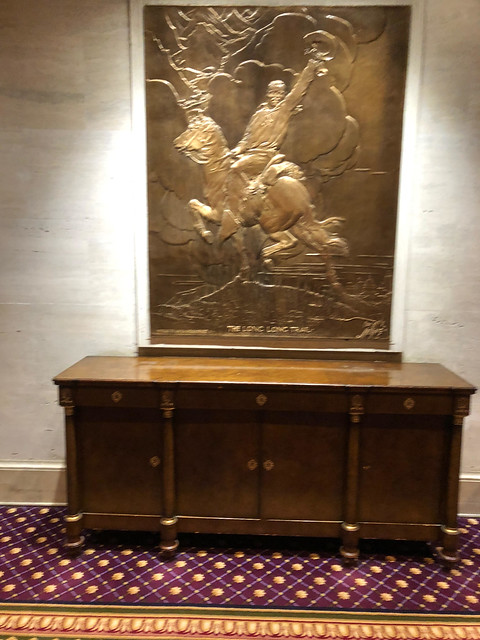
The Long Long Trail

The Life and Work of Laura Gardin Fraser
(http://news.coinupdate.com/the-life-and-work-of-laura-gardin-fraser-3389/)

NEW YORK INTERNATIONAL AIRPORT DEDICATION MEDAL
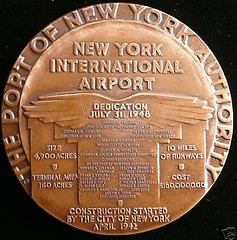
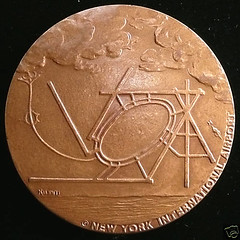
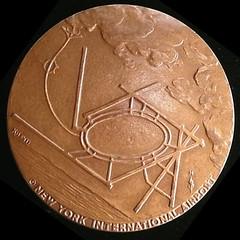 See the result to the right. Once this is done the Jamaica Bay coastline becomes geographically correct and not a horizon line. The sculptor could have helped the orientation by making his water lines run West-East rather than Northwest-Southeast. Although from an aerial POV water would usually just look flat.
See the result to the right. Once this is done the Jamaica Bay coastline becomes geographically correct and not a horizon line. The sculptor could have helped the orientation by making his water lines run West-East rather than Northwest-Southeast. Although from an aerial POV water would usually just look flat.

TIPS ON COIN DESIGN ORIENTATION
(http://www.coinbooks.org/v21/esylum_v21n08a14.html)
NOTES FROM E-SYLUM READERS: MARCH 18, 2018
Regarding the viewing of coins from an angle to see new perspectives intended by the designer, author Bob Van Arsdell writes:
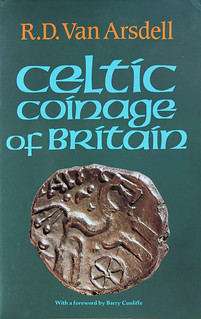
VIEWING COINS OBLIQUELY
(http://www.coinbooks.org/v21/esylum_v21n09a18.html)
ON ORIENTING AND VIEWING COINS
(http://www.coinbooks.org/v21/esylum_v21n10a13.html)
Bob Rightmire writes:

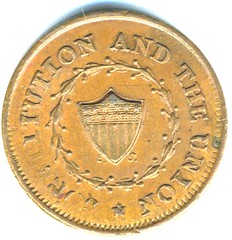
Fuld Patriotic Token 200/346
Images courtesy Q. David Bowers
http://www.cwtsociety.com/
QUERY: WHICH HETRICH-GUTTAG TOKEN IS NO. 10600?
(http://www.coinbooks.org/v21/esylum_v21n08a24.html)
Bob Rightmire writes:
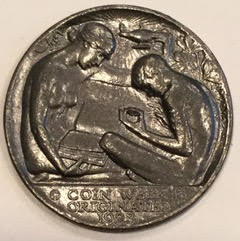
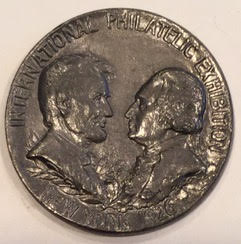
Bill Miller of Denton, MD writes:
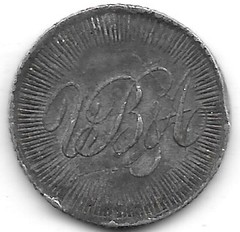
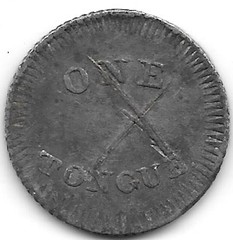
NOTES FROM E-SYLUM READERS: MAY 28, 2017 : More On the Mystery Item Struck on Civil War Token
(http://www.coinbooks.org/v20/esylum_v20n22a14.html)
Chris Bower of Indianapolis, IN writes:

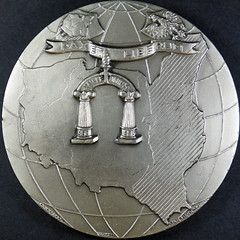
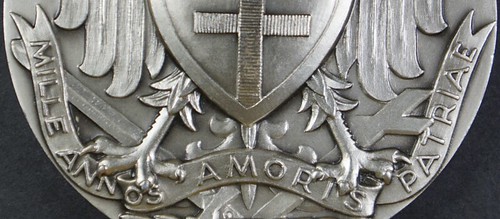
"MILLE ANNOS AMORIS PATRIAE" is
"Love of country thousands of years"

"PAX ET LIBERUM" is "PEACE AND FREEDOM"
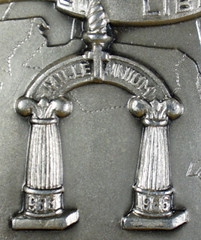
"MILLENNIUM" "966" "1966"
I can't make out all the words on the bottom edge but on the right is "STAN. KUPOLSKI"
-Editor

NEWMAN PORTAL ADDS ALASKAN ZNACHKI BULLETIN
(http://www.coinbooks.org/v21/esylum_v21n04a05.html)
SOVIET ERA RUSSIAN ZNACHKI
(http://www.coinbooks.org/v21/esylum_v21n04a30.html)
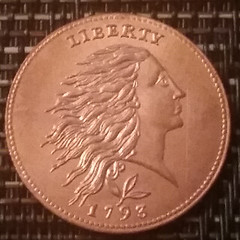 Pete Smith of Minneapolis writes:
Pete Smith of Minneapolis writes:
NOTES FROM E-SYLUM READERS: MARCH 11, 2018 : David Litrenta Token
(http://www.coinbooks.org/v21/esylum_v21n10a14.html)
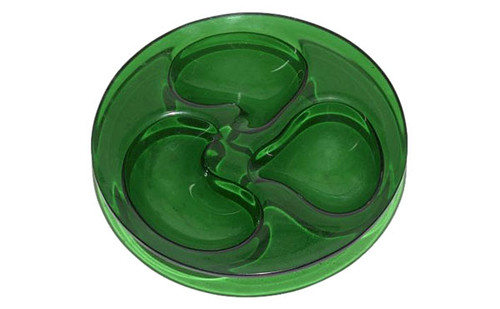
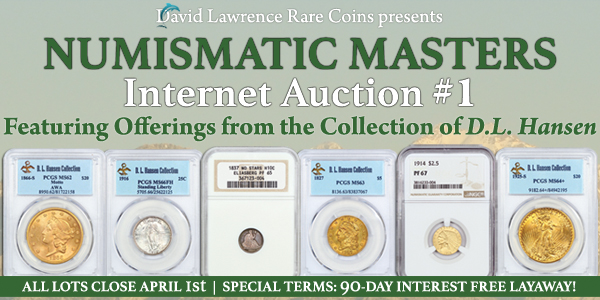
STEVE ROACH INTERVIEWS RUSS DOUGHTY
A: Some of my earliest memories involve digging through my great-grandfather’s coin collection. He was a banker in Talihina, Oklahoma, in the 1940s and 1950s and had many of those blue Whitman folders which he was trying to fill for his grandchildren. My great-aunt remembers him bringing home bags of cents from the bank and searching them. No one ever knew exactly what he was looking for, but undoubtedly, he was trying to fill as many holes as he could in the albums. Mercury dimes were my favorite coins at that time, and my mother loved them, too.
A: I became interested in Flying Eagle and Indian Head cents (IHCs) after completing my Lincoln cent set. IHCs were always one of my favorite coins and as a kid, my favorite belt buckle had several on prominent display. There is something about the color of the bronze planchet and the Indian Head design that I love. Before I started collecting IHCs, I dabbled a little bit in Lincoln cent die varieties, so when I started collecting IHCs, I knew a little bit about die varieties already. Soon, I was swept away into the wonderful world of die varieties on IHCs and searching for them added a new, challenging dynamic to my collecting. I’m always excited to find an IHC with a known die variety, or even better, to discover a new one. There are more varieties out there waiting to be discovered in the IHC series, so keep your eyes peeled. Who knows, you may even discover a new overdate!
A: My motivation for writing my book stems from my desire to help bring people into the hobby and make it more enjoyable for collectors. The goal of the book is to introduce what die varieties are and how they are made in a simple way that is suitable and affordable for all ages. My book fills a niche in that it is the only Top Variety guide for the Flying Eagle or IHC series. It works in conjunction with www.indianvarieties.com, where I’ve listed all known varieties and posted over 4,000 images. As we know, younger generations are increasingly consumed by their computers and mobile phones so I’ve worked very hard to bring these two series into that digital world through my website.
A: Organizing the text and graphics so they are informative and easy to read was a real challenge. My goal was to minimize the white space on the page by making the pictures and text as large as possible. I’d tell new authors to make sure you understand copyright laws and use publishing software where you can create templates so a design change can be applied to all pages. Invite others into your project to help and seek funding sources like the Central States Numismatic Society author grant program. Finally, make a final decision on the format and size of your book before you start laying it out. And have fun!
NEW BOOK: FLYING EAGLE AND INDIAN CENT VARIETIES
(http://www.coinbooks.org/v21/esylum_v21n10a03.html)
ROBERT READY’S BRITISH MUSEUM REPLICAS
BRITISH MUSEUM EXHIBIT: MONEY AND MEDALS
(http://www.coinbooks.org/v21/esylum_v21n08a22.html)

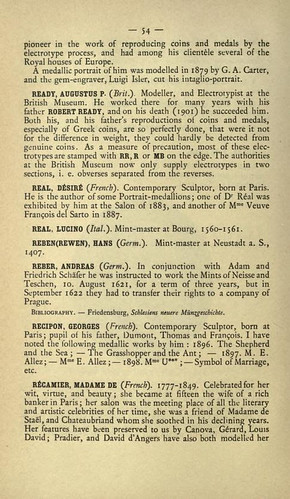
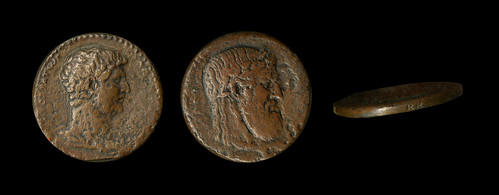
VOCABULARY TERM: BULLION
CLASS 06.1
NE12 {1917} FREY (P 35) QUOTES 16TH & 17TH REFERENCES.
NE42 {1982} DOTY (P 42) BULLION AS BACKING FOR PAPER MONEY.
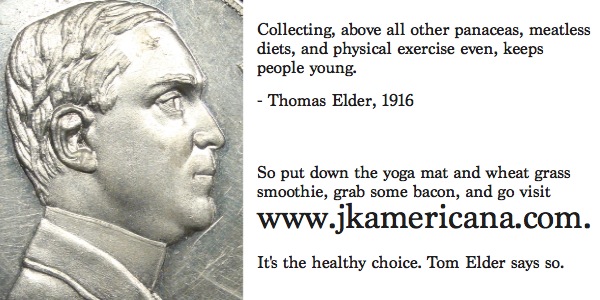
OTTO CURTIS LIGHTNER (1886-1950)
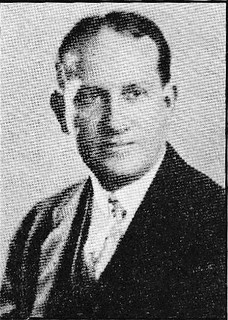 Otto C. Lightner is best known as the publisher of Hobbies, The Magazine for Collectors, the successor to Philatelic West. Through his magazine he did much in promoting various fields of collecting, autographs, antique furniture, china, silver, stamps, coins and paper money, buttons, dolls and just about anything collectible. His stamp and coin departments were important in the history of American numismatics which were run by various celebrities over the years and filled with a rich assortment of articles and advertisements.
Otto C. Lightner is best known as the publisher of Hobbies, The Magazine for Collectors, the successor to Philatelic West. Through his magazine he did much in promoting various fields of collecting, autographs, antique furniture, china, silver, stamps, coins and paper money, buttons, dolls and just about anything collectible. His stamp and coin departments were important in the history of American numismatics which were run by various celebrities over the years and filled with a rich assortment of articles and advertisements.
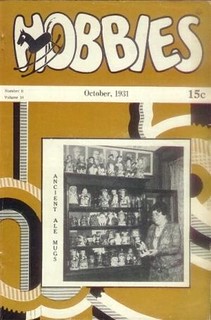 In 1906, he began his career as a typesetter for a Kansas City newspaper, The Daily Journal.
In 1906, he began his career as a typesetter for a Kansas City newspaper, The Daily Journal.
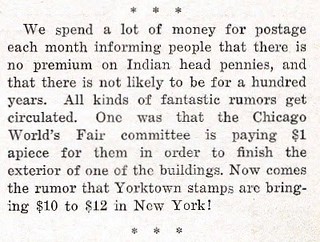 In 1930, Chicago held its first annual Antiques Exposition and Hobby Fair, which inspired Lightner to not only attend with an exhibit and booth for Hobbies not only to help launch it but also to include a strong antiques focus in the magazine.
In 1930, Chicago held its first annual Antiques Exposition and Hobby Fair, which inspired Lightner to not only attend with an exhibit and booth for Hobbies not only to help launch it but also to include a strong antiques focus in the magazine.
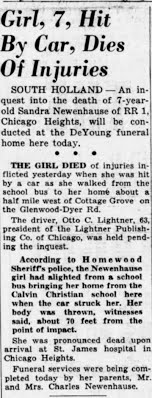 On August 20, 1947, Lightner bought the old Hotel Alcazar in Saint Augustine, Florida to open as a Hobbies Museum.
On August 20, 1947, Lightner bought the old Hotel Alcazar in Saint Augustine, Florida to open as a Hobbies Museum.
LIGHTNER, OTTO CURTIS
(https://sites.google.com/a/numismaticmall.com/www
/numismaticmall-com/lightner-otto-curtis)
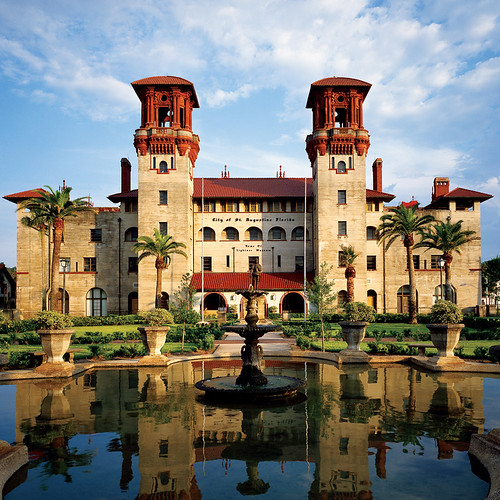
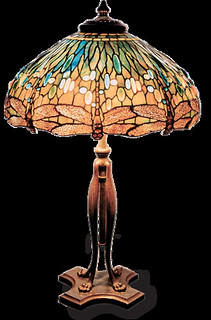 The current mission of the Museum is to preserve, maintain, research and interpret the Museum’s collections for the educational benefit of the visiting public. The Museum is a non-profit cultural institution sustained by admissions and donations, and it is supported by a dedicated staff of volunteers.
The current mission of the Museum is to preserve, maintain, research and interpret the Museum’s collections for the educational benefit of the visiting public. The Museum is a non-profit cultural institution sustained by admissions and donations, and it is supported by a dedicated staff of volunteers.
http://lightnermuseum.org/
https://nnp.wustl.edu/library/publisherdetail/523056
POPSICLE TOKENS
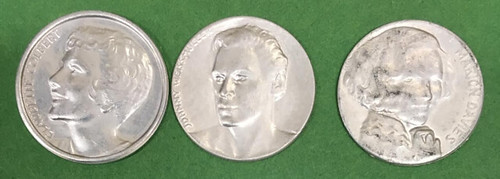

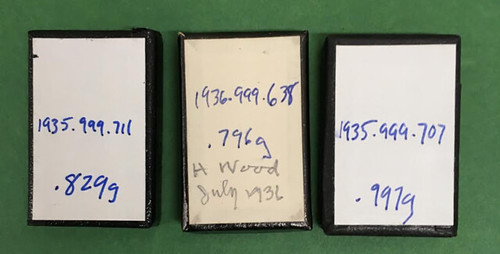
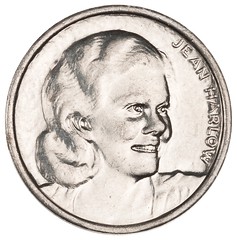
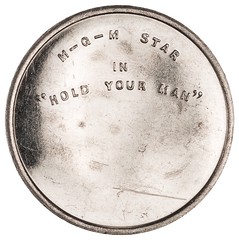
Another ANS Harlow token: "Hold Your Man"


An ANS Adam Peitz medal of Jean Harlow
U.S. MINT SCULPTOR-ENGRAVER ADAM PEITZ
(http://www.coinbooks.org/v21/esylum_v21n10a12.html)
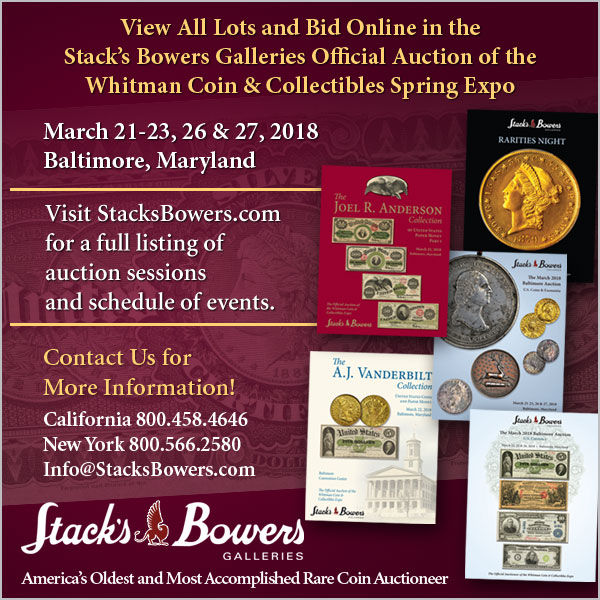
RECOVERING OLD OBSOLETE COMPUTER FILES
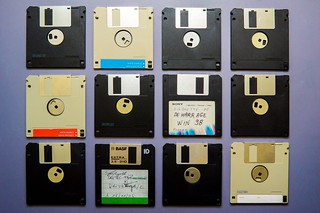 NOT SO VERY LONG AGO, web designers’ ambitions outstripped the infrastructure of the internet, so they had to resort to physical media to help carry their ideas. Dial-up modems were pokey, and the sluggish speed couldn’t handle large images or streaming video. “People did all sorts of projects that were too heavy for the live web,” says Tim Walsh, a digital archivist at the Canadian Centre for Architecture (CCA).
NOT SO VERY LONG AGO, web designers’ ambitions outstripped the infrastructure of the internet, so they had to resort to physical media to help carry their ideas. Dial-up modems were pokey, and the sluggish speed couldn’t handle large images or streaming video. “People did all sorts of projects that were too heavy for the live web,” says Tim Walsh, a digital archivist at the Canadian Centre for Architecture (CCA).
The Quest for a Universal Translator for Old, Obsolete Computer Files
(https://www.atlasobscura.com/articles/how-to-open-old-computer-files)
AN OLD BUT NEW LOOK AT THE BOOK
(http://www.coinbooks.org/v21/esylum_v21n10a31.html)
RUTGERS DIGITIZES ROMAN COIN COLLECTION
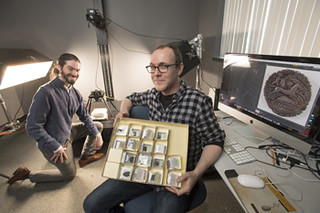 The Rutgers University Libraries have digitized an invaluable collection of 1,250 coins from the ancient Roman Republic, some dating to the beginning of coinage – and just time for the Ides of March.
The Rutgers University Libraries have digitized an invaluable collection of 1,250 coins from the ancient Roman Republic, some dating to the beginning of coinage – and just time for the Ides of March.
Rutgers Digitizes Roman Coin Collection, Making it Accessible to the World
(https://news.rutgers.edu/news/rutgers-digitizes-roman-coin-collection-making-it-accessible-world/20180314#.Wq8A_yjwaAv)

THE AMERICAN LEGION COIN DESIGN PROCESS
by Dennis Tucker, CCAC
 My thoughts go to my family and World War II. Many of my uncles served in the Army and Navy during
the war, in places far distant from their homes in central New York. While they were in Europe and on the
high seas, the rest of the family was thousands of miles away, doing their part for the war effort on the
home front. Newspaper articles tell how my Grandma Tucker and other wartime moms and wives baked
and held events for local military associations. By that time the American Legion was already more than
twenty years old—chartered in 1919, in the fresh wake of the world’s last huge war, before my uncles
were even born. For the United States, World War I had lasted about a year and a half, April 1917 to
November 1918, and it involved four million service members and their families and communities. In
World War II we fought two years longer than that, December 1941 to August 1945, and rallied the
efforts of more than sixteen million U.S. troops. It was after this second global conflict that membership
in the American Legion boomed, nearly doubling. In the 1940s the Legion had more than three million
members.
My thoughts go to my family and World War II. Many of my uncles served in the Army and Navy during
the war, in places far distant from their homes in central New York. While they were in Europe and on the
high seas, the rest of the family was thousands of miles away, doing their part for the war effort on the
home front. Newspaper articles tell how my Grandma Tucker and other wartime moms and wives baked
and held events for local military associations. By that time the American Legion was already more than
twenty years old—chartered in 1919, in the fresh wake of the world’s last huge war, before my uncles
were even born. For the United States, World War I had lasted about a year and a half, April 1917 to
November 1918, and it involved four million service members and their families and communities. In
World War II we fought two years longer than that, December 1941 to August 1945, and rallied the
efforts of more than sixteen million U.S. troops. It was after this second global conflict that membership
in the American Legion boomed, nearly doubling. In the 1940s the Legion had more than three million
members.
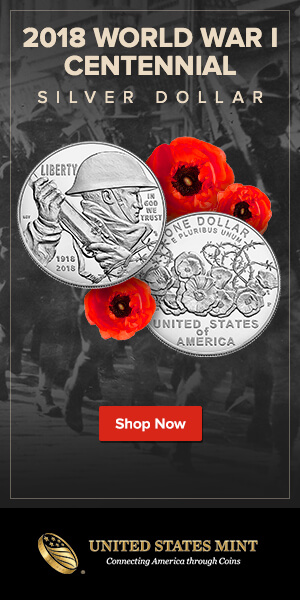 Our advisory committee, however, was not forced to stick to those proposed pairings. Committee member
Jeanne Stevens-Sollman, a highly respected American sculptor, and one of only a few living recipients of
the J. Sanford Saltus Award for Outstanding Achievement in the Art of the Medal, remarked on the
complexity of the portfolio. She approached our task by choosing six designs she felt worked to tell the
American Legion’s story.
Our advisory committee, however, was not forced to stick to those proposed pairings. Committee member
Jeanne Stevens-Sollman, a highly respected American sculptor, and one of only a few living recipients of
the J. Sanford Saltus Award for Outstanding Achievement in the Art of the Medal, remarked on the
complexity of the portfolio. She approached our task by choosing six designs she felt worked to tell the
American Legion’s story.
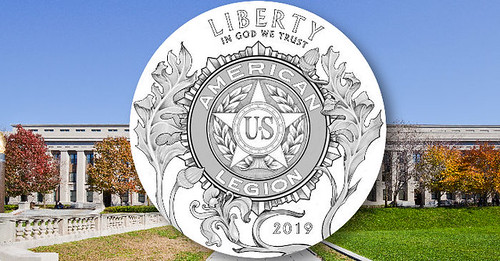
Celebrating the American Legion—and America’s veterans—with coins
(http://news.coinupdate.com/celebrating-the-american-legion-and-americas-veterans-with-coins/)
BILL SEEKS PUT TO WOMEN ON QUARTERS
Lawmakers push to put women on quarters
(http://money.cnn.com/2018/03/15/news/women-quarters-rosie-rios/index.html)
A 16TH CENTURY COIN CABINET?
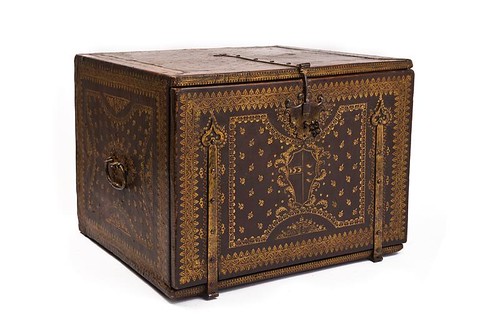
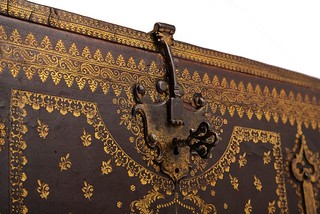
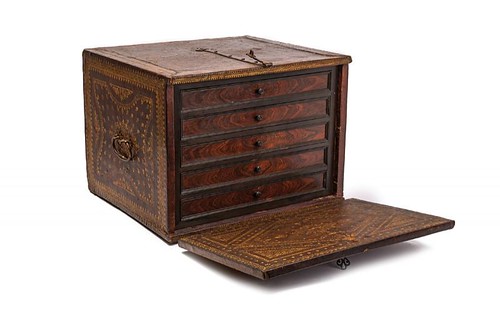
LOT 543 A RARE MONEY BOX
(https://www.the-saleroom.com/en-gb/auction-catalogues/czerny-international-auction-house-ltd/catalogue-id-srcz10019/lot-f4afb179-1e11-43e2-a2fc-a89000e9e4f0)
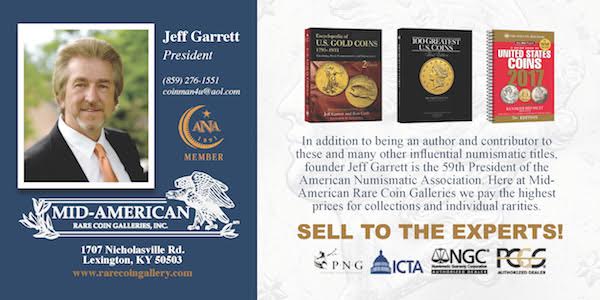
NUMISMATIC NUGGETS: MARCH 18, 2018
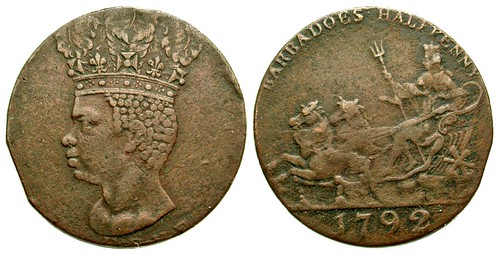
Lot 352. Barbados. Copper 1/2 Penny Token. 1792. Low mintage.
(https://www.agoraauctions.com/listing/viewdetail/39587)
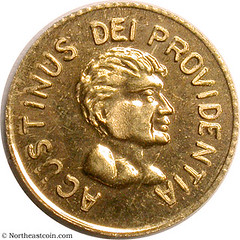
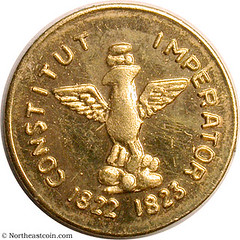
1823 dated Mexico Gold Restrike
(https://www.northeastcoin.com/viewImageStandalone.jsp?itemKey=zi26_9301187)
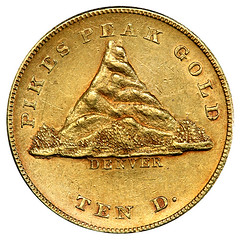
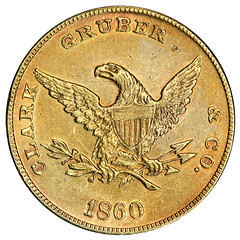
1860 $10 CLARK GRUBER PCGS AU58
(http://hlrc.com/Inventory/CoinViewer?id=868556001&c=23)
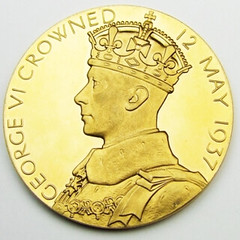
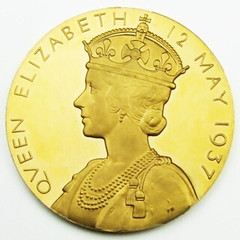
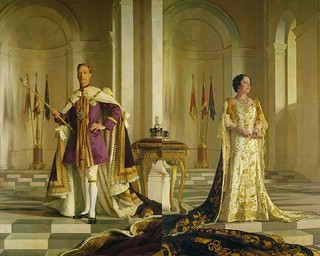 The coronation of George VI and Elizabeth Bowes-Lyon as King and Queen of the United Kingdom and the Dominions of the British Commonwealth and as Emperor and Empress of India took place at Westminster Abbey, London, on 12 May 1937. George VI ascended the throne upon the abdication of his brother, Edward VIII, on 11 December 1936, three days before his 41st birthday. Edward's coronation had been planned for 12 May 1937 and it was decided to continue with his brother and sister-in-law's coronation on the same date.
The coronation of George VI and Elizabeth Bowes-Lyon as King and Queen of the United Kingdom and the Dominions of the British Commonwealth and as Emperor and Empress of India took place at Westminster Abbey, London, on 12 May 1937. George VI ascended the throne upon the abdication of his brother, Edward VIII, on 11 December 1936, three days before his 41st birthday. Edward's coronation had been planned for 12 May 1937 and it was decided to continue with his brother and sister-in-law's coronation on the same date.
Coronation of King George VI and Queen Elizabeth
(https://en.wikipedia.org/wiki/Coronation_of_King_George_VI
_and_Queen_Elizabeth)
Lot
106
A King George VI and Queen Elizabeth Coronation gold medal, ...
(https://www.easyliveauction.com/catalogue/lot/2d235c2f56b4903b88bc951504f6c334/
0af8d24542e81eb9357e7ef448a6646f/select-sale-including-collectors-sale-lot-106/)
THE RALPH AND LOIS STONE COLLECTION
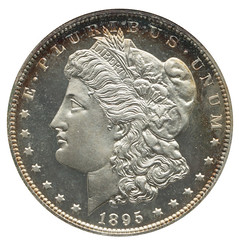
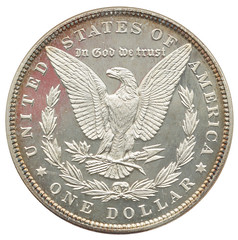
 The Stone Collection also includes a complete set of Three Cent Silver pieces, all certified to be of at least MS-65 (gem) quality and submitted to CAC; an essentially complete set of U.S. Silver Commemorative coins (1892-1954), again all in MS-65 condition; a small selection of U.S. gold coins, and an original set of the 1915 Panama-Pacific Commemorative coins, which includes two examples of the fifty dollar denomination, the largest ever produced by the U.S. Mint. The sale will also include a selection of Indian peace medals from a distinguished private collection featuring an exceptionally rare Andrew Johnson peace medal inscribed by presidential order.
The Stone Collection also includes a complete set of Three Cent Silver pieces, all certified to be of at least MS-65 (gem) quality and submitted to CAC; an essentially complete set of U.S. Silver Commemorative coins (1892-1954), again all in MS-65 condition; a small selection of U.S. gold coins, and an original set of the 1915 Panama-Pacific Commemorative coins, which includes two examples of the fifty dollar denomination, the largest ever produced by the U.S. Mint. The sale will also include a selection of Indian peace medals from a distinguished private collection featuring an exceptionally rare Andrew Johnson peace medal inscribed by presidential order.
Historic Coins and Medals
Featuring Magnificent Morgan Silver Dollars from the Collection of Ralph and Lois Stone
(http://www.sothebys.com/en/auctions/2018/historic-coins-and-medals-n09975.html)
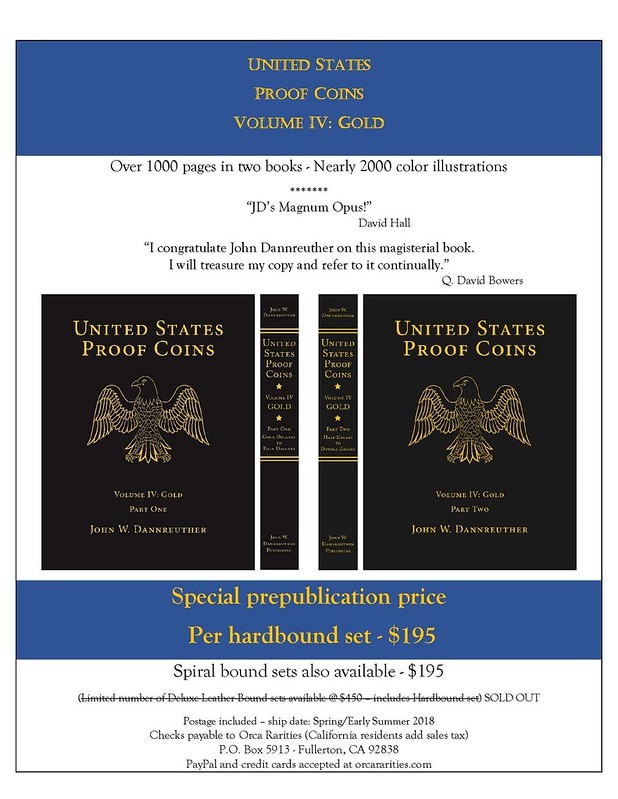
WAYNE'S NUMISMATIC DIARY: MARCH 18, 2018
There was untold excitement at E-Sylum Central on Monday March 12, 2018 as a package arrived from Tsoi Wing Yip in Hong Kong. In it was the new Wheat Cent mouse pad I'd ordered for my desk from an eBay seller. It was a long overdue replacement for one I'd used for so many years I've lost track. Distributed by the U.S. Mint, it was gifted to me by reader David Gladfelter. It's clearly seen better days. For grins, I'll happily donate it as a gag lot / precious E-Sylum souvenir for this year's Numismatic Bibliomania Society benefit auction (I'll donate something nice from my library as well).


Old and New Mousepads
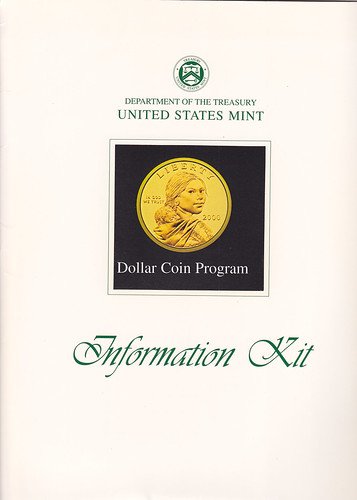
Sacagawea dollar Information Kit
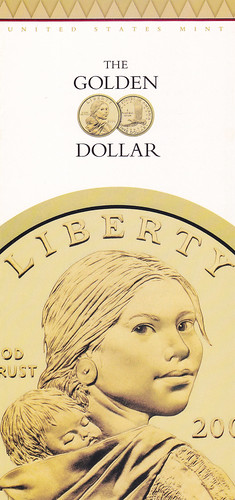

Sacajawea dollar brochure and bookmark
This week's big event was the regular March meeting of Nummis Nova, my Northern Virginia numismatic social group. Our host was Tom Kays, and he'd made reservations at Clyde's restaurant near Alexandria for Tuesday, March 13, 2018.
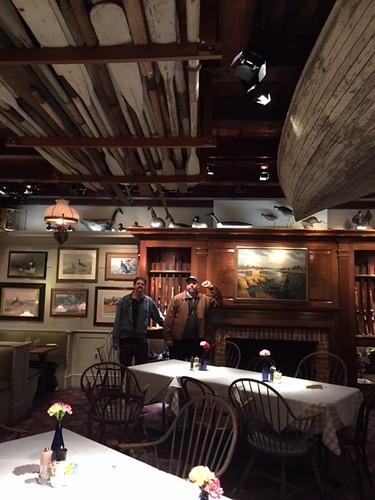 It wasn't long before Dave Schenkman and Gene Brandenburg arrived, and we all headed toward our table. It was in a nearby room decorated with a hunting theme - there were racks of rifles next to the fireplace, and scores of duck decoys on shelves all around the room. Very cozy. Gene Brandenburg took this long shot of Wayne Herndon and Tom Kays.
It wasn't long before Dave Schenkman and Gene Brandenburg arrived, and we all headed toward our table. It was in a nearby room decorated with a hunting theme - there were racks of rifles next to the fireplace, and scores of duck decoys on shelves all around the room. Very cozy. Gene Brandenburg took this long shot of Wayne Herndon and Tom Kays.
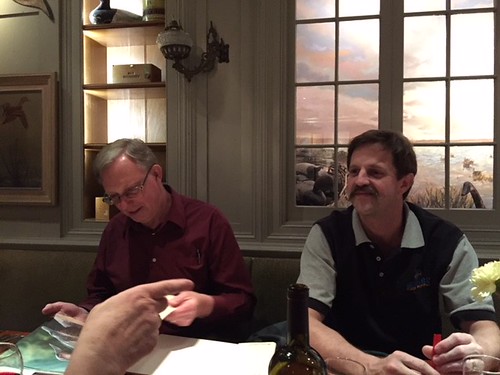
Wayne Homren and Wayne Herndon with Dave Schenkman "pointing at the culprit"
Image and caption by Gene Brandenburg

Mike Packard, Tom Kays, Steve Bishop
"3 Amigos - Tom loves his phone"
Image and caption by Gene Brandenburg
Robert brought some ancient coins I'd purchased at NYINC to use as auction lots for an upcoming Kids Event at the Annandale coin show. He'd taken them home and attributed them for us. Thanks! It gave us an opportunity to discuss the last event.
It was a memorable one, and since I haven't had a chance to write it up yet, I'll do it in the next article. It took place March 3, 2018.
Now back to Tuesday's Nummis Nova meeting. We always have some interesting material on hand, and here are some examples. Host Tom Kays challenged attendees as follows:

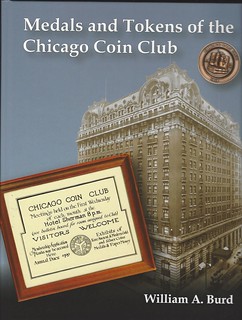
Dave Schenkman brought these delightful political satire notes.

Note #1 Front
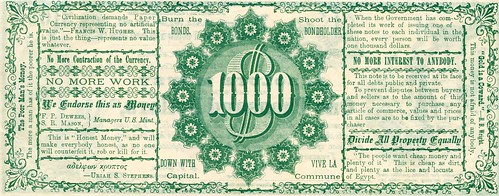
Note #1 Back
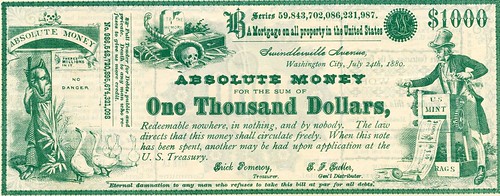
Note #2 Front (same Back as #1)
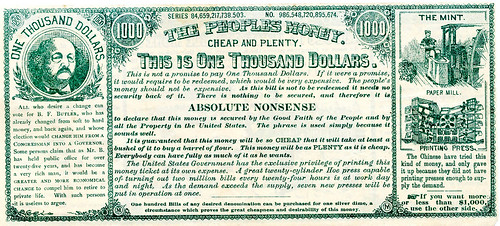
Note #3 Front
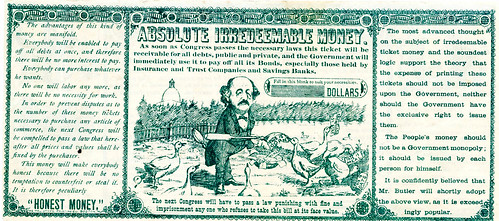
Note #3 Back
Mike Packard brought this great piece of ephemera from dealer David Litrenta that makes a great companion for the tokens discussed earlier.
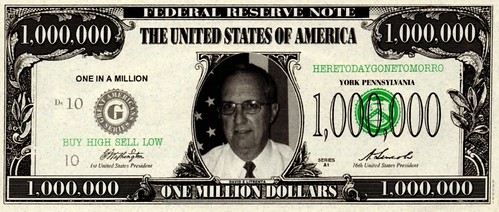

Tom brought a treasure poke filled with replicas of various coins. I spread them out for this picture.
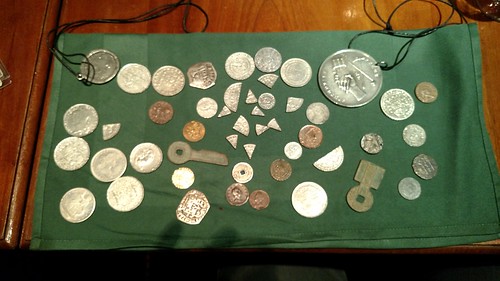
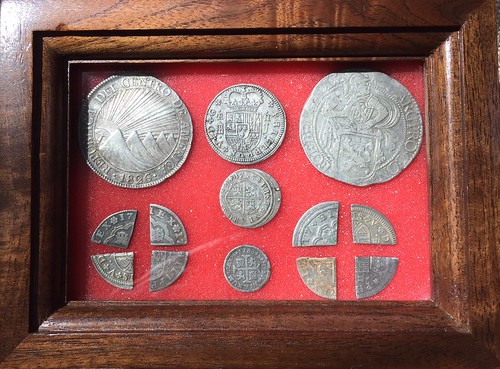
In the What-exactly-ARE-these-anyway? department, Dave Schenkman writes:
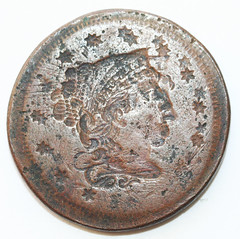
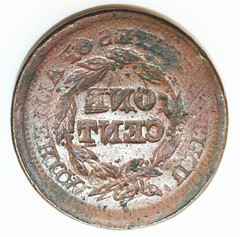

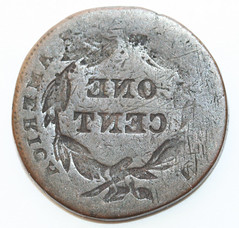
Here are some of the items Steve Bishop brought to show.
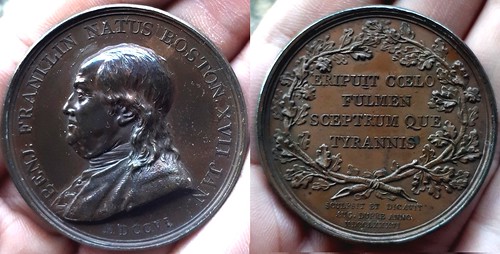
1786 Franklin Natus Boston Medal
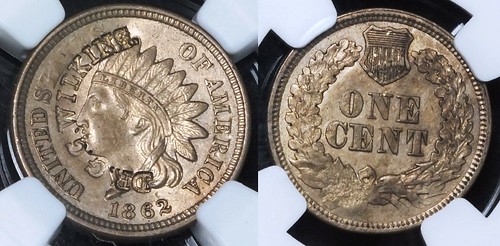
1862 Indian Cent CS Wilkins NGC MS62
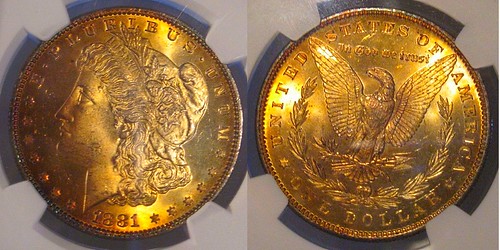
1881 Morgan NGC MS64 Plus Toned
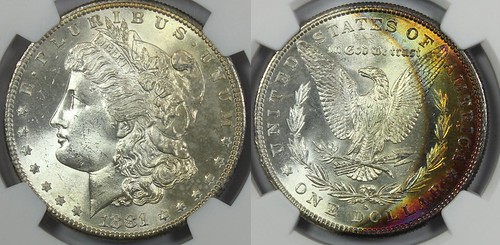
1881-S Morgan Toned NGC MS64 Star Toned
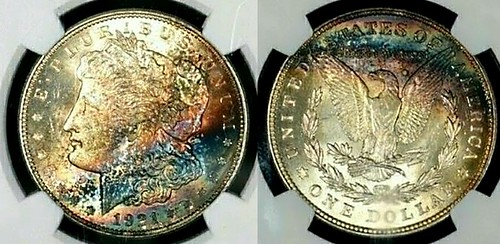
1921 Morgan NGC MS63 Star Toned
Here are a couple shots by Tom Kays.
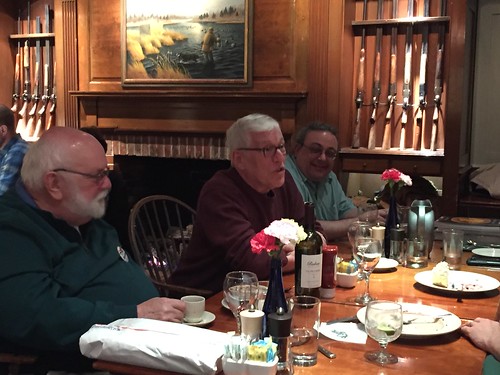
Gene Brandenburg, Dave Schenkman, Eric Schena

Eric Schena, Wayne Homren, Wayne Herndon
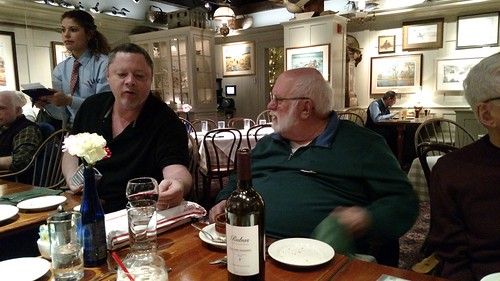
Lenny (far left), Robert, Gene, and Dave
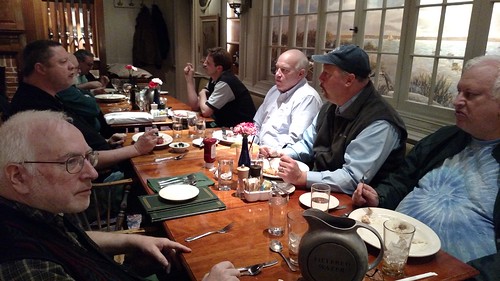
LEFT,from foreground: Lenny, Robert
RIGHT, from foreground: Steve, Tom, Mike, Wayne Herndon
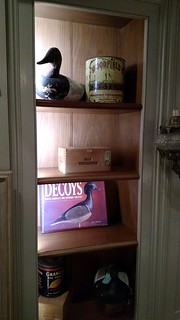 Behind me was this shelf. Things aren't nailed down, since apparently their usual crowd is more reserved and well-behaved. I took a closer look at the Decoys book and discovered it was published by Krause Publications, an unexpected numismatic connection. Yeah, I put it back. Since the full title is The 100 Best Decoys we were expecting something in a Whitman Publications series.
Behind me was this shelf. Things aren't nailed down, since apparently their usual crowd is more reserved and well-behaved. I took a closer look at the Decoys book and discovered it was published by Krause Publications, an unexpected numismatic connection. Yeah, I put it back. Since the full title is The 100 Best Decoys we were expecting something in a Whitman Publications series.

WAYNE'S NUMISMATIC DIARY: MARCH 3, 2018
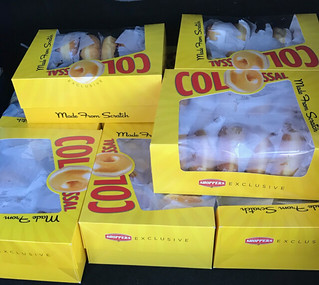 Later I was dispatched to buy donuts for the dealers and while I was at it bought breakfast for the three of us. The sight of thirteen dozen Colossal Donuts from the local supermarket inspired my son to snap a photo of the trunk of my car.
Later I was dispatched to buy donuts for the dealers and while I was at it bought breakfast for the three of us. The sight of thirteen dozen Colossal Donuts from the local supermarket inspired my son to snap a photo of the trunk of my car.

Registration table image courtesy Tom Kays
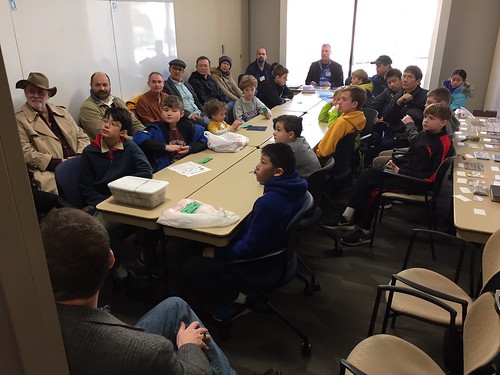
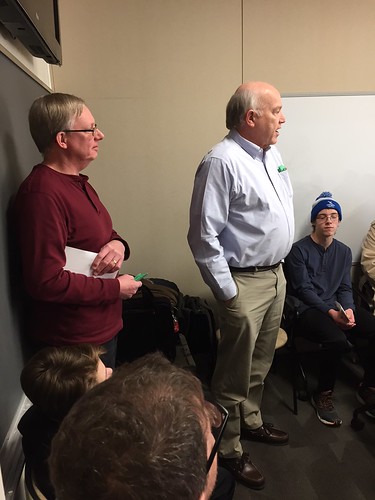

LEFT: Wayne Homren and Mike Packard standing
RIGHT: auction lot viewing
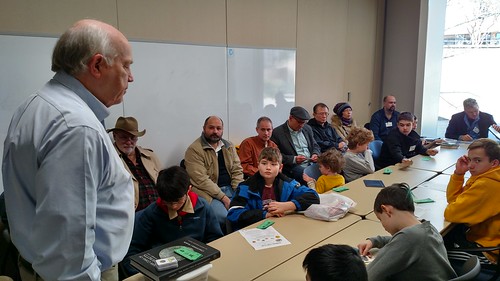
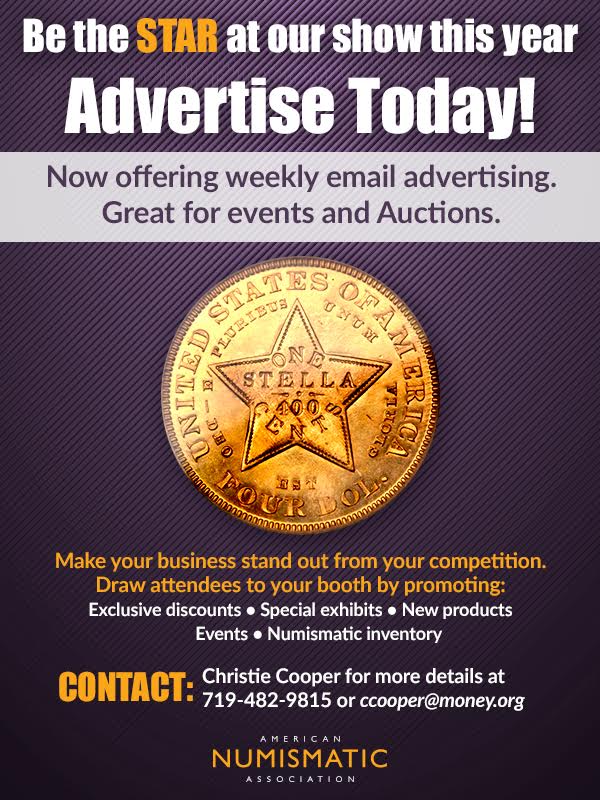
THE MAN WHO INVENTED BOOKSELLING
Ron Haller-Williams of Surbiton, Surrey, England writes:
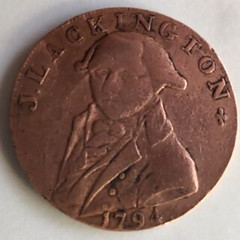
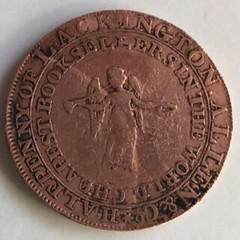
1794 Halfpenny Token: J L. Lackington. Booksellers
(https://www.ebay.co.uk/itm/292469873150

THE MAN WHO INVENTED BOOKSELLING AS WE KNOW IT
(https://lithub.com/the-man-who-invented-bookselling-as-we-know-it/)
CIVIL WAR GOLD TALES IN THE NEWS
A 155-year-old legend about buried federal gold appears to have caught the attention of the FBI.
FBI went to site of suspected lost Civil War gold in Pennsylvania
(https://www.usatoday.com/story/news/nation-now/2018/03/17/fbi-went-site-suspected-lost-civil-war-gold-pennsylvania/434674002/)
Has $55MILLION of gold lost during the Battle of Gettysburg finally been discovered? FBI descends on site where treasure hunters claim they found the haul
(http://www.dailymail.co.uk/news/article-5511135/FBI-site-Civil-War-gold-rumored-buried.html)
Chasing the Myth of Confederate Gold
(https://www.history.com/news/confederate-gold-jefferson-davis)
GOLD BARS FALL FROM RUSSIAN AIRPLANE
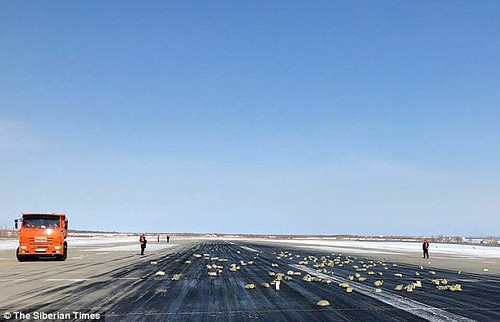
Gold litters the runway
Gold galore! Siberians scour the tundra for $370m worth of gold, platinum and diamonds that FELL OUT of a plane - and one lucky treasure hunter finds a gold bar worth $500k in the snow
(http://www.dailymail.co.uk/news/article-5508951/Siberians-rush-gold-diamonds-fell-plane.html)
Loosely in the sky with diamonds! Russian plane loses its $400million cargo of gold and jewels after a hatch falls off during takeoff
(http://www.dailymail.co.uk/news/article-5504253/Plane-loses-265-million-cargo-gold-jewels.html)

